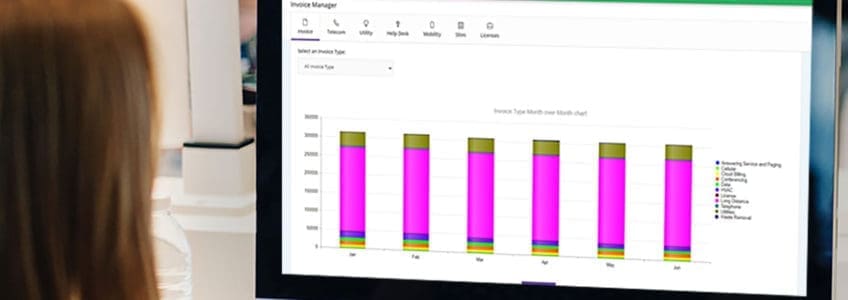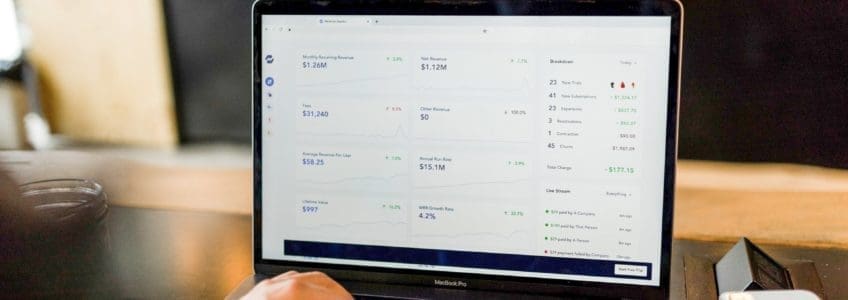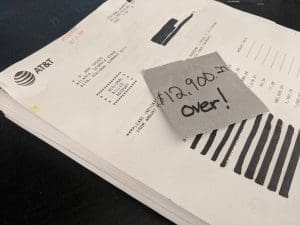Financial Technology
Imagine a future where you’re in full control of your telecom and utility expenses. RadiusPoint is dedicated to providing insights and resources that empower you and your team for the full lifecycle of your telecom and utility invoices,.Read More
Customer Service at its Best
Over 33 years of experience allow us to identify and resolve client issues.Read More
Expense Management Services
Tailored Solutions That Maximize Value and Meet Your Budget
We understand that finding the right service provider means balancing your goals with your budget. That’s why we specialize in creating fully customized solutions designed to deliver maximum value for every dollar spent. Our pricing reflects the care and expertise we put into every project—no cookie-cutter services here.
Your needs and custom solution drive the pricing model with the monthly cost aligning with the annual expense. Costs can be applied per invoice processed monthly, an hourly fee for project-based tasks, or help desk tasks.
What Can You Expect to Invest?
Our services are as unique as your needs, and pricing varies based on factors like the number of locations and invoices to be managed, the annual dollar volume, and the level of services required. We provide services at three different levels but can tailor a service to meet your specific needs:
- Host & Load
- Receiving and loading invoices monthly
- Missing bill retrieval
- Basic
- All Host & Load services
- Invoice payment
- GL Interface file
- Accrual file
- Enhanced
- All Host & Load and Basic services
- Invoice audit and reconciliation
- Contract management
- Access to our Help Desk ticketing module
- Asset Management module
Clients provide their invoice information and desired services, and we create a tailored solution and pricing. We’re here to help you explore the right options for your goals and budget requirements.
A Few of the Driving Factors:
- Type of services: Telecom, IT, Wireless, or Utilities
- Number of locations: How many locations will we be managing?
- Annual dollar volume: The monthly fee is based on a percentage of your telecom and IT spend.
- Number of utility invoices: How many invoices will we receive and process?
- Wireless devices: How many devices will be under management?
Lastly, think about what services you want to take off your plate. Many clients need us to simply load the invoices and manage daily tasks like auditing, reconciling, and paying invoices. Enhanced Services allow you and your team to focus on core business tasks while we ensure all invoices are paid on time.
Why Choose Us?
Bringing unique value to the partnership is our key focus, and we differentiate our services, software, and problem-solving team in several ways:
- ExpenseLogic Software: Our in-house developed and maintained software can be tailored to any Business Intelligence needs.
- Combines eight software packages into one: accounting, expense audit, help desk, asset management, contract management, document management, wireless management, and reporting analytics.
- Enables seamless collaboration across finance, operations, facilities, and real estate departments.
- Invoice Reconciliation: We handle incorrect billing by disputing errors and recovering overcharges, shouldering the burden for you.
- High ROI: Our clients achieve an average ROI of over 400%.
- Effortless Onboarding: Our team manages vendor transitions and invoice setup seamlessly. Clients frequently commend our efficiency during this phase.
- Proven Experience: Over 33 years of expertise with continuous innovation. Our software is now in its 10th release.
- Exceptional Retention: Client retention exceeds 98% over the past six years, with many clients partnering with us for nearly two decades.
What’s Included in Your Investment?
- Custom-Tailored Solutions: We develop solutions specifically aligned with your goals and operational needs.
- Dedicated Problem-Solving Staff: Our team collaborates closely with your organization to address challenges and implement effective strategies.
- Seamless Collaboration: You’ll work directly with an experienced Account Team committed to understanding your business.
- Exceptional Post-Project Support: We remain available to answer questions, provide guidance, and ensure sustained success after implementation.
- Transparent Processes: We keep you informed every step of the way, ensuring clarity and confidence in the services provided.
- Focus on Your Business Needs: Our staff takes pride in proactively solving problems, offering innovative solutions, and adapting to the unique demands of your business environment.
Provide us with the services that are needed, and we will tailor a solution and pricing to meet those needs.
Client Testimonials
Our clients consistently praise our expertise, efficiency, and ability to deliver meaningful results. Here are just a few success stories:
Efficient Setup in 4 Weeks
“I cannot speak highly enough about your team. The RP team supported our team through managing the challenging vendor base, providing great guidance and all the necessary tools required for success. The implementation was FAST but also successful. Most implementations that go as fast as this have hiccups, and we had very few items to clean up after go live.”
Ease of Use
“The features provided are very helpful and the system is very user-friendly.”
Time-Saving
“I have been more organized than ever. My time is precious, and countless hours have been saved.”
Improved Vendor Management
“RadiusPoint has helped us streamline our vendor relationships and keep our expenses in check. Their team’s dedication to resolving disputes and ensuring accurate billing has saved us both time and money.”
Scalable Solutions
“As we expanded, RadiusPoint adapted seamlessly to our growing needs. Their tailored approach and comprehensive software have been invaluable.”
These testimonials demonstrate the trust our clients place in us and the results we deliver. Whether you need help managing a few locations or scaling solutions across a nationwide network, we’re here to help.
Ready to Learn More? Let’s Talk!
Contact us today for a no-pressure consultation. We’ll explore your needs and provide a customized plan that works for you. Visit us at Contact Us or Schedule a Discovery Call
2024 Gartner press release
For immediate release:
Orlando, FL November 27, 2024 – The 2024 Gartner Market Guide for Telecom Expense Management Services recognizes RadiusPoint as a Representative Vendor, affirming its position as a premier single-source SaaS platform and BPO service provider in the TEM services sector, a testament to its over three decades of market presence.
Gartner states, “To be commercially and operationally efficient, enterprises must eliminate service redundancy and ensure that all services add value to the business. TEM providers are offering program management capabilities to oversee fragmented estates spanning multiple carriers, lines of business, contracts and internal organizational units.”
When sourcing a TEM vendor, Gartner recommends best practices, “To increase the chances of a successful engagement, it is critical to conduct due diligence regarding what the provider will deliver and how that will be achieved.”
As a result of the ongoing advancements in the IT market, RadiusPoint is consistently enhancing the features and functionalities of its proprietary software, ExpenseLogic. RadiusPoint is committed to providing business intelligence, and ExpenseLogic empowers businesses to attain a favorable return on investment. Moreover, it helps transform the complexity of telecom management into streamlined efficiency while optimizing and reducing communication expenses, including IoT, mobile, fixed line, and cloud devices, as well as utility costs.
The success of businesses hinges on the precision and meticulous attention to detail required for technology and utility invoices and inventory every month. All financial transactions must be meticulously documented and systematically monitored, providing easy access for auditing and reporting through a unified platform. Alongside pinpointing costly billing errors, RadiusPoint’s exclusive software, ExpenseLogic, grants clients access to a range of Internet billing options that can be efficiently processed and managed within its IoT section. The flexibility of their service delivery enables RadiusPoint to adapt and scale as required.
“We are thankful to be included in Gartner’s Market Guide as a Representative Vendor, as we believe their key findings and recommendations are highly valued for enterprises of all sizes. Our flexibility and automation allow us to move faster and hold hands easier, said Sharon Watkins, CEO of RadiusPoint. “We believe Gartner provides clear evidence for those in the IT arena to make informed business decisions so you can focus on your core business strategy.”
Earning a place in the Gartner 2024 Market Guide for Telecom Expense Management Services represents a significant milestone for RadiusPoint and marks the sixth year of inclusion in this guide.
Subscribers to Gartner can find the 2024 Market Guide for Telecom Expense Management Services here.
Disclaimer: Gartner does not endorse any vendor, product, or service depicted in its research publications, and does not advise technology users to select only those vendors with the highest ratings or other designation. Gartner research publications consist of the opinions of Gartner’s research organization and should not be construed as statements of fact. Gartner disclaims all warranties, expressed or implied, with respect to this research, including any warranties of merchantability or fitness for a particular purpose.
About RadiusPoint
Established in 1992, RadiusPoint is a prominent provider of services encompassing Telecom Expense Management (TEM), Utility Expense Management (UEM), Wireless Expense Management (WEM), and Mobile Device Management (MDM). Located at its corporate headquarters in Orlando, Florida, RadiusPoint offers a comprehensive range of business and technology solutions, all aimed at enhancing the global business performance of its clients.
RadiusPoint is proud to be a 2025 SSON Sponsor
March 2025 –
We are thrilled to announce that RadiusPoint is a proud sponsor of the Shared Services Outsourcing Network (SSON) Orlando Conference taking place from March 24 – 27, 2025!
This premier event brings together the brightest minds in shared services and global business. It’s your chance to connect with industry leaders, gain insights from top experts, and network with peers who are shaping the future of our field.
Mark your calendars and make plans to join us in sunny Orlando for an unforgettable experience of learning, collaboration, and innovation. We look forward to seeing you there and sharing in the excitement of this incredible gathering!
Stay tuned for more updates and information as the event approaches. Let’s make SSON Orlando 2025 a standout occasion together!
Role of Utility Expense Management in Enhancing Sustainability
The Crucial Role of Utility Expense Management (UEM) in Enhancing Sustainability
In the pursuit of a more sustainable future, businesses and organizations are increasingly turning their attention to the management of utility expenses. Energy, water, and other utility costs not only impact the bottom line but also have significant environmental implications. By implementing effective utility expense management (UEM) strategies, businesses can reduce resource consumption, lower costs, and contribute to a more sustainable planet.
Understanding Utility Expense Management
Utility expense management involves the monitoring, analysis, and optimization of energy, water, and other utility costs within an organization. It encompasses various practices, including tracking usage patterns, identifying inefficiencies, implementing conservation measures, and leveraging technology to optimize resource consumption.
Benefits of UEM for Sustainability
- Reduced Environmental Impact: By actively managing utility expenses, organizations can identify areas of excessive resource consumption and implement measures to reduce waste. For example, businesses can significantly decrease their carbon footprint and conserve valuable natural resources by investing in energy-efficient appliances, optimizing heating and cooling systems, and minimizing water usage.
- Cost Savings: Effective utility expense management not only benefits the environment but also yields significant cost savings for businesses. By reducing energy and water consumption, organizations can lower their utility bills and allocate resources to other areas of operation. Additionally, many sustainability initiatives, such as installing solar panels or upgrading to energy-efficient lighting, may qualify for financial incentives and rebates, further enhancing cost savings.
- Enhanced Corporate Social Responsibility (CSR): Demonstrating a commitment to sustainability through responsible resource management can enhance an organization’s reputation and brand image. Consumers and stakeholders increasingly expect businesses to operate in an environmentally responsible manner. By actively managing utility expenses and reducing environmental impact, companies can strengthen their CSR initiatives and attract environmentally-conscious customers and investors.
- Regulatory Compliance: As governments worldwide enact stricter environmental regulations, businesses face increasing pressure to comply with sustainability standards. Effective utility expense management can help organizations meet regulatory requirements by reducing emissions, conserving resources, and adopting eco-friendly practices. By staying ahead of regulatory changes, businesses can avoid fines and penalties while positioning themselves as leaders in sustainability.
- Long-Term Resilience: Investing in sustainability through utility expense management fosters long-term resilience for businesses. By reducing reliance on finite resources and minimizing exposure to volatile energy markets, organizations can mitigate risks associated with resource scarcity and price fluctuations. Embracing sustainability also future-proofs businesses against evolving consumer preferences and regulatory trends, ensuring continued relevance and competitiveness in a rapidly changing world.
Best Practices for Utility Expense Management
- Conducting Regular Audits: Regularly assess utility bills, meter readings, and consumption patterns to identify areas of inefficiency and opportunities for improvement.
- Implementing Energy-saving Technologies: Invest in energy-efficient appliances, lighting systems, and HVAC equipment to reduce energy consumption and lower utility costs.
- Employee Engagement: Educate employees about the importance of resource conservation and encourage participation in sustainability initiatives through training programs and incentive schemes.
- Leveraging Technology: Utilize energy management software, smart meters, and IoT devices to monitor and control utility usage in real time, enabling proactive decision-making and optimization.
- Setting Targets and KPIs: Establish clear sustainability goals, such as reducing energy consumption by a certain percentage or achieving specific emissions targets, and track progress using key performance indicators (KPIs).
Conclusion
Effective UEMt is a cornerstone of sustainable business practices, offering environmental, economic, and social benefits. By optimizing resource consumption, reducing costs, and demonstrating a commitment to environmental stewardship, organizations can enhance their competitiveness, strengthen their brand reputation, and contribute to a more sustainable future for generations to come. Embracing sustainability through utility expense management is not only a strategic imperative but also a moral obligation in the face of global environmental challenges.
Factors That Impede Your Inventory Efforts
Factors That Impede Your Inventory Efforts
Creating and maintaining an inventory of your telecommunications services, invoices, and vendors is a substantial undertaking that demands consistent attention to detail. Ensuring the cleanliness and accuracy of this inventory is a challenging task, often requiring dedicated daily efforts. Engaging the services of a Telecom Expense Management (TEM) company is essential in effectively managing these tasks.
Many organizations opt to outsource the periodic inventory assessment of their telecom services and invoices. While some may view this as a sporadic necessity, often with a minimal financial benefit, a more strategic approach suggests otherwise. Rather than periodic assessments, an audit encompassing a comprehensive inventory conducted once, followed by regular maintenance, offers a more pragmatic solution.
The practicality of maintaining a clean inventory on an ongoing basis is often hindered by time constraints within most companies. However, partnering with a reputable TEM provider enables the execution of this task every month. This proactive approach not only mitigates the risks of overbilling but also streamlines the recovery process for any erroneous charges. Additionally, any recovered funds resulting from the initial audit can be efficiently managed and shared, maximizing overall savings and efficiency.
Challenges in Maintaining an Accurate Inventory of Telecom Services
Many factors contribute to an organization needing help maintaining an accurate inventory.
- Absence of Corporate Contracts: When corporate contracts are lacking, employees may independently enter into agreements, resulting in higher service costs.
- Decentralized Spending: This occurs when employees make equipment purchases without organizational oversight, leading to inefficiencies.
- Inaccurate Inventory: Without proper tracking of telecom and IT services at each location and for each employee, overspending is likely due to duplicate or unnecessary services.
Addressing these factors is crucial for effective inventory management of telecom services. Implementing corporate policies and contracts can help control spending. Engaging a reputable Telecom Expense Management (TEM) company is the initial step in assessing service distribution through a comprehensive Inventory and Audit. This process necessitates a thorough examination of services beyond superficial refunds, providing detailed descriptions of phone or circuit numbers, monthly charges, service types, and features.
Enhancing Cost Reduction Strategies with Comprehensive TEM Solutions
Upon establishing an accurate inventory, a Telecom Expense Management (TEM) system empowers organizations to consistently drive cost reductions by offering comprehensive visibility into their communication ecosystem and invoice lifecycles. Centralizing all telecom-related data in a unified repository, accompanied by robust reporting tools, facilitates precise cost assessments, aids in identifying and disputing billing discrepancies, streamlines contract management including contract imaging and auditing, and uncovers optimization opportunities. Additionally, capacity planning and call accounting functionalities mitigate resource wastage within the network.
This goes beyond just telecom. A good TEM vendor will provide a comprehensive cost reduction management strategy that includes both telecom and IT, managing the complete communications lifecycle. The accuracy behind these transactions is vital to the overall efficacy of the organization.
Steps to Maintain a Clean Inventory
Keeping the inventory clean will be affected by the following:
- Monthly services being added.
- Monthly services being disconnected.
- Employees moving to different departments, being hired or terminated.
- Vendor’s changes in monthly fees.
To maintain a clean inventory every month, it is imperative to establish an order process that fosters transparency throughout the organization. Integration of a Help Desk module within the TEM provider’s software is instrumental in capturing all moves, additions, changes, or disconnects effectively. This ensures a seamless transition of new invoices to accounting without delay for coding, thereby preventing overpayment for previously disconnected services.
The next critical step in maintaining inventory accuracy is invoice and service validation. Conducting a monthly audit of each invoice and charge is essential for any TEM company. This line-item audit enables prompt identification of overcharges and provides an efficient mechanism to notify vendors for dispute and recovery. Rigorous tracking of disputes to ensure proper crediting on invoices is paramount in the recovery process facilitated by TEM services.
Optimizing Inventory Accuracy
Maintaining the accuracy of your monthly inventory relies heavily on verifying it against the established baseline inventory. A reputable TEM provider should offer validation services with select telecom vendors, enabling swift identification and rectification of discrepancies to prevent recurring overcharges on subsequent invoices.
Leveraging its proprietary SAAS platform, ExpenseLogic, RadiusPoint facilitates the creation of a concise list of invoices and services for monthly validation against the baseline inventory. This validation process provides organizations with a clear overview of services at each location, streamlining interactions with telecom vendors and pinpointing opportunities for cost reduction by identifying unnecessary services. Partnering with the right TEM provider can significantly save time, money, and resources while empowering internal teams to take control of expenses.
Diving Into Your Trash
Waste management stands as a sizable industry that is essential for every company. In the United States alone, a staggering 624,700 metric tons of trash get discarded daily, incurring an annual expense of approximately $11 billion. Businesses shoulder a substantial 80% of these expenses. Across the board, companies are actively seeking strategies to curtail costs while simultaneously minimizing waste generation and maximizing recycling opportunities wherever feasible.
Invoices and Fees
The initial phase of cost reduction in waste management involves scrutinizing usage patterns and existing services. Numerous companies grapple with expensive monthly waste services, often burdened by additional charges appended to their regular service bills. These fees often include:
- Management fees
- Environmental fees
- Gas surcharge fees
- Lock fees
- Extra Pick-up fees
- Contamination fees
- Overage fees
- Locked gate fees
By comprehending the invoice details and extra fees, you can effectively optimize your cost savings.
Questions to Ask
Some of the above fees can be eliminated or negotiated just by asking the right questions including:
- Do we need a separate bin for environmental waste? This could involve quick-service restaurants discarding spoiled food or spent grease.
- Can we recycle cardboard, plastic, and metal? Breaking down boxes for recycling might save both money and the environment.
- Is there a vendor we can use to collect scrap metal? This move could cut costs for larger roll-off bins and potentially lead to rebates.
- Are any bins situated behind locked gates? If trash collection is hindered due to inaccessibility, expect additional fees. To avoid this, place bins outside locked areas or coordinate gate access on pickup days.
- Are extra pickup fees a routine on your invoices? A quick review of the invoice can help resolve this by adjusting bin size or pickup frequency.
- Is there a corporate contract governing waste services? Ensure your team is aware of this contract to benefit from agreed-upon rates when ordering services.
Given the array of questions, it’s evident that most companies will require support in overseeing trash invoices and managing multiple service providers. Generating detailed, precise information crucial for optimal business decisions demands dedicated time and meticulous attention to detail from a skilled team.
Problems with Billing Complexity
The billing intricacies present a convoluted mix of charges that necessitate monthly and long-term analysis to pinpoint the most optimal services at the most favorable prices. Monthly invoices might vary, with additional charges appearing one month and none the next, leading to potential confusion. It’s crucial to meticulously identify each charge on the invoice every month to ensure informed business decisions for each location.
Vendors contribute to this complexity by offering multiple trash haulers within a single area. This approach proves more advantageous than having only one hauler since multiple options enable bidding and price competition. However, managing these multiple vendors requires a dedicated effort and a specific finesse to navigate pricing and negotiate contract terms effectively.
Optimization Solutions with RadiusPoint
Having a partner who can break down the invoice monthly is critical to effectively managing your trash or waste services and meeting your sustainability goals. RadiusPoint’s Waste Optimization process involves a deep dive into the waste invoices and current business programs and policies to provide a multi-point approach to managing waste services. This inventory and audit process delivers an environmentally responsible waste management program that assists in reaching waste initiatives and provides unmatched value.
RadiusPoint’s optimization involves investigating services with the current vendor and determining best practices to provide a cost-saving program to our clients. Many multi-location organizations have ordered services as needed with no thought given to contract terms, bin size, or the frequency of pick-up. All of these factors determine the monthly cost and could result in huge savings if managed with cost savings, efficiency, and program goals in mind.
During our inventory and audit of the waste services, RadiusPoint would:
- Obtain a copy of the vendor’s current contract.
- Validate the contract rates against the current invoice.
- Comparison of services across all sites for any anomalies.
- Identifying any overage charges or other charges beyond the normal pick-up charges.
- Identifying better rates for those locations not under contract.
- Identifying better rates and possible early termination penalties, if applicable, for those locations under contract.
- Identify and recommend service changes to eliminate overage charges.
- Provided consolidated report for Request for Proposal (RFP).
- Provide analysis once the RFP is returned to show savings.
- Assist with contract negotiations for each contract or global contract.
- Assist with issues that arise at the location during the term of the agreement.
Once the inventory and audit is complete, RadiusPoint employs our exclusive software, ExpenseLogic, to handle and settle the monthly invoice. Simultaneously, continued auditing is conducted to guarantee precise billing according to contracted rates.
Connect with us to learn how RadiusPoint will support you in achieving your business’s waste service savings goals.
Why Your Company Needs a Managed Mobility Service Provider
The Strategic Imperative: Why Your Company Needs a Managed Mobility Service Provider
Is your company struggling to keep up with the rapidly evolving mobile landscape?
Are you overwhelmed by the complexities of managing a growing number of mobile devices and applications?
If so, it’s time to consider partnering with a managed mobility service provider. In this article, we will explore why your company needs the expertise of a managed mobility service provider to stay ahead of the game.
With the proliferation of smartphones, tablets, and other mobile devices, organizations are facing a multitude of challenges when it comes to managing their mobile ecosystem.
From device procurement and provisioning to security and support, there are numerous tasks that need to be handled efficiently and effectively. A managed mobility service provider can help streamline these processes, allowing your company to focus on its core competencies.
By leveraging the expertise of a managed mobility service provider, you can ensure that your company’s mobile infrastructure is optimized for productivity and cost-effectiveness.
These providers have the knowledge and experience to implement best practices, ensuring that your mobile devices and applications are secure, up-to-date, and fully utilized.
Don’t let your company fall behind in the mobile revolution. Partner with a managed mobility service provider and stay ahead of the game.
Benefits of partnering with a managed mobility service provider
Managing a growing number of mobile devices and applications can be a daunting task for companies of all sizes. The complexities involved in device procurement, provisioning, security, and support can quickly become overwhelming.
Without the right expertise and resources, companies may struggle to effectively manage their mobile ecosystem. This is where a managed mobility service provider can make a significant difference.
How a managed mobility service provider can help optimize your company’s mobility strategy?
1. Expertise and Knowledge
Managed mobility service providers specialize in the management of mobile devices and applications. They have the expertise and knowledge to navigate the complexities of the mobile landscape, ensuring that your company’s mobile infrastructure is optimized for success.
2. Cost Savings
By partnering with a managed mobility service provider, you can reduce the total cost of ownership of your mobile devices. These providers have the resources and relationships to negotiate favorable pricing for device procurement and support services.
Additionally, they can help you identify and eliminate unnecessary expenses, saving your company money in the long run.
3. Enhanced Security
Mobile devices are vulnerable to security threats, making it essential to have robust security measures in place.
Managed mobility service providers have the expertise to implement comprehensive security solutions, protecting your company’s sensitive data and mitigating the risk of cyberattacks.
4. Streamlined Processes
Managing a large number of mobile devices and applications can be time-consuming and resource-intensive. A managed mobility service provider can streamline these processes, automating tasks such as device provisioning, software updates, and application deployment.
This allows your IT team to focus on more strategic initiatives, improving overall efficiency and productivity.
Key features to look for in a managed mobility service provider
When choosing a managed mobility service provider, it’s essential to consider the following key features:
5. Expertise and Experience
Look for a provider with extensive experience in managing mobile devices and applications. They should have a proven track record of success and a deep understanding of industry best practices.
6. Comprehensive Service Offering
Ensure that the provider offers a comprehensive range of services, including device management, application management, security, and expense management. This will ensure that all aspects of your company’s mobile ecosystem are covered.
7. Scalability
Consider the scalability of the provider’s services. Your company’s mobile needs may grow and evolve, so it’s important to choose a provider that can scale its services to accommodate future requirements.
8. Robust Security Measures
Mobile security is of paramount importance. Choose a provider that has robust security measures in place, including encryption, two-factor authentication, and mobile threat defense.
9. Flexibility and Customization
Every company has unique mobility requirements. Look for a provider that offers flexible and customizable solutions to meet your specific needs. They should be willing to work closely with you to understand your business objectives and tailor their services accordingly.
The value of investing in a managed mobility service provider for your company’s success
Managed mobility services will continue to play a vital role in helping companies navigate the ever-changing mobile landscape. As technology advances and new challenges emerge, the expertise of managed mobility service providers will become even more valuable.
With the increasing adoption of IoT devices, the rise of 5G networks, and the growing need for enhanced security, companies will rely on these providers to optimize their mobility strategies and ensure their competitive edge.
RadiusPoint Recognized as a Distinguished Vendor in the 2024 Amalgam Insights Vendor SmartList
For immediate release:
Orlando, FL January 23rd, 2024 – RadiusPoint, a renowned name in the Technology Expense Management (TEM) services sector, proudly announces its recognition as a Distinguished Vendor in the 2024 Amalgam Insights Vendor SmartList. The SmartList, themed “Why TEM Matters More Than Ever in a Cloud, SaaS, and AI World,” serves as a testament to RadiusPoint’s exceptional contributions and expertise in the industry.
Amalgam Insights, a trusted source for technology insights, has distinguished RadiusPoint as a standout performer in the TEM landscape. This recognition reflects RadiusPoint’s position as a premier single-source SaaS platform and Business Process Outsourcing (BPO) service provider. With over three decades of unwavering commitment to excellence, RadiusPoint continues to lead the way in delivering innovative solutions that align with the evolving needs of a Cloud, SaaS, and AI-driven world.
Amalgam Insights states; “Organizations seeking to contextualize telecom, mobility, and IT spend with broader accounting activity, including facilities visibility and ESG reporting, are best positioned to get the most value from RadiusPoint. As companies worldwide emphasize spending accountability within all divisions and, at the same time, require metrics for their social responsibility efforts, they must think beyond managing disciplines in a siloed fashion. Combining telecom, mobility, IT, and facilities administration into a single practice delivers holistic insight while improving productivity, efficiency, and costs,”
“We are honored to be recognized by Amalgam Insights as a Distinguished Vendor in their prestigious Vendor SmartList,” said Sharon Watkins, CEO at RadiusPoint. “This acknowledgment underscores our dedication to providing cutting-edge TEM services and reinforces our commitment to delivering value to our clients in an ever-changing technological landscape.”
RadiusPoint expresses gratitude to Amalgam Insights for this distinguished recognition and looks forward to continuing its mission of excellence in the TEM services sector.
To learn more about Amalgam Insights, please visit their website here.
The full Amalgam Insights Vendor SmartList is available to download here.
About RadiusPoint
RadiusPoint is a leading provider of Technology Expense Management (TEM) services, offering a comprehensive suite of solutions to manage, optimize, and control technology expenses. With over 30 years of industry experience, RadiusPoint is committed to delivering innovative and cost-effective TEM services in a rapidly evolving technology landscape.
Waste Services Case Study: 28% Reduction in Trash Spend
28% Reduction in Trash Spend
Trimming expenses on waste management serves as the initial step in an organization’s sustainability journey. A prominent elevator company operating worldwide successfully slashed its monthly waste expenditure by 28%. Additionally, by securing a corporate contract, they paved the way for greater savings across their new locations, fortifying their commitment to sustainability.
Issues
Our client grappled with numerous challenges in its billing and services. Upon conducting an initial review, it became evident that over 40 locations had individually inked contracts with local waste haulers. Consequently, these contracts staggered in expiration, often incurring hefty early termination fees. This complexity rendered negotiating a unified corporate contract unfeasible within the initial twelve months of gaining contract and service visibility.
Solution
To tackle these issues, the organization teamed up with RadiusPoint. Collaborating on bill processing and payment services for their monthly waste invoices, RadiusPoint unearthed a route toward cost reduction during the standard optimization process.
RadiusPoint’s optimization process delved into scrutinizing services provided by the existing vendor, aiming to uncover contractual obligations and service specifics. Numerous locations had ordered services sporadically without considering contract terms, bin sizes, or pickup frequency. RadiusPoint conducted a comprehensive analysis across the organization, tailoring services to match the office types and specific service requirements to ensure an appropriate fit.
During our inventory and audit of the waste services, RadiusPoint:
- Obtained a copy of the vendor’s current contract.
- Validated the contract rates against the current invoice.
- Compared services across all sites for any anomalies.
- Identified overage charges or other charges beyond the normal pick-up charges.
- Identified better rates for those locations not under contract.
- Identified better rates and possible early termination penalties, if applicable, for those locations under contract
- Recommend service changes to eliminate overage charges.
- Provided consolidated report for Request for Proposal (RFP).
- Provided analysis once RFP is returned to show savings.
- Assisted with contract negotiations for each contract or global contract.
- Managed the transition project.
- Assisted with issues that arose at the location during the term of the agreement.
Results
Partnering with RadiusPoint empowered the client to leverage our exclusive software, ExpenseLogic. This tool facilitated the seamless processing and payment of monthly invoices while concurrently conducting an audit to guarantee precise billing per contracted rates. This meticulous approach culminated in an impressive 28% decrease in monthly waste expenses. Embracing transparency in management paves the way for astute business choices, fostering cost-effectiveness, operational efficiency, and the achievement of sustainability objectives. Entrust RadiusPoint to guide you toward attaining your business savings targets, specifically with your waste services.
The Future of Cost Optimization: TEM Services are Leading the Way
How RadiusPoint Telecom Expense Management Services are Leading the Way
As RadiusPoint Telecom Expense Management (TEM) services continue to revolutionize cost optimization in the telecom industry, businesses are now equipped with the tools they need to stay ahead of the game. With its cutting-edge technology and innovative solutions, RadiusPoint has positioned itself as a leader in helping companies streamline their telecom expenses while achieving significant cost savings.
In this article, we will delve into the future of cost optimization and how RadiusPoint TEM services are paving the way for businesses to optimize their telecom expenses like never before. By leveraging their extensive experience and industry knowledge, RadiusPoint provides customized solutions tailored to each client’s unique needs.
With cost optimization becoming increasingly crucial in today’s competitive landscape, businesses need a reliable partner like RadiusPoint to navigate the complexities of managing telecom expenses. Their proactive approach, coupled with their innovative software, helps businesses identify potential areas of cost savings and implement effective strategies to optimize their telecom spend.
Stay tuned as we explore how RadiusPoint TEM services are leading the way in cost optimization and discover how your business can benefit from their expertise.
The challenges of cost optimization in telecom expenses
Cost optimization plays a vital role in the success of any business. In today’s highly competitive market, where every penny counts, companies are constantly seeking ways to reduce expenses and increase profitability. Telecom expenses, in particular, can be a significant drain on a company’s resources. With the increasing reliance on telecommunications for business operations, companies must optimize telecom spend to remain competitive.
Effective cost optimization allows businesses to allocate their resources efficiently, ensuring that every dollar spent delivers maximum value. By identifying and eliminating unnecessary expenses, businesses can free up capital for investments in growth opportunities, product development, and innovation. Cost optimization also helps businesses improve their bottom line, increase profitability, and enhance their overall financial health.
How RadiusPoint’s TEM services work
Cost optimization in telecom expenses presents unique challenges for businesses. The telecom industry is complex, with multiple service providers, various billing structures, and a wide range of services and technologies. Managing and controlling telecom expenses can be a daunting task, especially for businesses with multiple locations or a large number of employees.
One of the main challenges in TEM is the lack of visibility into telecom spend. Without a centralized system to track and monitor expenses, businesses may struggle to identify inefficiencies and cost-saving opportunities. Additionally, the ever-evolving nature of the telecom industry means that businesses need to stay up-to-date with the latest technologies, services, and pricing plans to ensure they are getting the best value for their money.
Another challenge is the complexity of telecom invoices. Telecom bills can be confusing, with multiple line items, different rates, and various fees and surcharges. Without a thorough understanding of telecom billing, businesses may miss out on potential cost-saving opportunities or fall victim to billing errors and overcharges.
Key features of RadiusPoint’s TEM services
RadiusPoint’s TEM services offer a range of key features that set them apart from other TEM providers. These features include:
- Invoice Processing and Auditing: RadiusPoint’s proprietary software, ExpenseLogic, automates the invoice processing and auditing process, ensuring accurate and timely payment of telecom bills. This eliminates the need for manual invoice processing, reduces the risk of errors, and improves overall efficiency.
- Expense Tracking and Reporting: ExpenseLogic provides real-time visibility into telecom expenses, allowing businesses to track costs, monitor usage, and generate detailed reports. This helps businesses make informed decisions, identify cost-saving opportunities, and optimize their telecom spend.
- Contract and Vendor Management: RadiusPoint helps businesses manage telecom contracts and relationships with service providers. They negotiate favorable contract terms, monitor contract compliance, and ensure that businesses are getting the best value for their money.
- Cost Allocation and Chargeback: ExpenseLogic enables businesses to allocate telecom expenses to different cost centers or departments, making tracking and managing telecom spending across the organization easier. This feature is particularly useful for businesses with multiple locations or complex organizational structures
The benefits of outsourcing telecom expense management services
RadiusPoint has helped numerous businesses achieve significant cost savings through their TEM services. Let’s take a look at a few real-life success stories:
- RadiusPoint assisted a multi-location nonprofit by identifying the existing local telecom service utilized across six locations, meeting specific landline requirements. They successfully identified all needs and found a superior service at a reduced monthly cost, resulting in a $12K reduction in total monthly expenses across the six locations.
- RadiusPoint’s software, ExpenseLogic, found a contract overcharge on local phone lines for a discount retailer, ongoing for months. RadiusPoint collaborated with the carrier to secure an $82K credit and prevent a $12,000 monthly expense.
- ExpenseLogic discovered services billed for three months despite being closed and disconnected for a restaurant group. RadiusPoint collaborated with the vendor, resulting in a $5,761 credit from the vendor.
The future of cost optimization in TEM
Outsourcing telecom expense management to RadiusPoint offers several key benefits for businesses:
- Expertise and Industry Knowledge: RadiusPoint’s team of experts has extensive experience in the telecom industry. They are well-versed in the latest technologies, services, and pricing plans, enabling them to provide valuable insights and recommendations to optimize telecom expenses.
- Time and Resource Savings: Managing telecom expenses in-house can be a time-consuming and resource-intensive task. By outsourcing to RadiusPoint, businesses can free up their internal resources and focus on core business activities, while leaving the complexities of TEM to the experts.
- Cost Savings: RadiusPoint’s cost optimization strategies and negotiation skills help businesses achieve significant cost savings. By identifying inefficiencies, eliminating unnecessary expenses, and negotiating better rates, businesses can reduce their telecom spend and improve their bottom line.
- Improved Visibility and Control: ExpenseLogic provides businesses with real-time visibility into their telecom expenses, allowing them to track costs, monitor usage, and generate detailed reports. This improved visibility and control enable businesses to make informed decisions, identify cost-saving opportunities, and optimize their telecom spend.
How RadiusPoint is leading the way in telecom expense management services
The future of cost optimization in telecom expenses looks promising, with technological advancements and the rise of innovative solutions. As businesses continue to rely on telecommunications for their operations, the need for effective cost optimization will only grow.
One key trend in cost optimization is the increasing use of artificial intelligence (AI) and machine learning (ML) technologies. These technologies can analyze large volumes of data, identify patterns, and make intelligent recommendations for cost savings. By leveraging AI and ML, businesses can automate the process of identifying cost-saving opportunities and implementing optimization strategies.
Another trend is the integration of TEM with other business systems. By integrating TEM with enterprise resource planning (ERP) systems, businesses can gain a holistic view of their expenses and improve overall cost control. This integration allows for better coordination between different departments and ensures that telecom expenses are aligned with business objectives.
Conclusion
RadiusPoint is at the forefront of telecom expense management services, leading the way in cost optimization for businesses. Their innovative EXpenseLogic software, experienced team, and customer-centric approach set them apart from other providers in the industry.
RadiusPoint’s proactive approach to cost optimization helps businesses stay ahead of the game. They continuously monitor the telecom industry for new technologies, services, and pricing plans, ensuring that their clients are getting the best value for their money. Their team of experts works closely with clients to understand their unique needs and develop customized cost-optimization strategies that deliver tangible results.
By leveraging RadiusPoint’s expertise and innovative software, businesses can streamline their telecom expenses, identify cost-saving opportunities, and implement effective strategies to optimize their telecom spend.
Healthcare Case Study: Telecom Expenses Down by 26% in Healthcare
Reducing Telecom Expenses by 26% in Healthcare
RadiusPoint collaborated with an Assisted Living and Nursing Home organization to enhance their oversight of telecom, IT, and wireless expenses. Serving as their telecom expense management (TEM) partner, RadiusPoint offered comprehensive insight into their invoices and spending and the range of services and equipment deployed across each site. This detailed visibility enabled RadiusPoint to identify and deactivate over 700 dormant business lines at various locations leading to a 26% reduction of their annual spend or $475k once the lines were disconnected and removed from the invoices.
Background
Given the healthcare industry’s focus on emergency preparedness, there’s a constant demand for reliable access to emergency personnel. Landlines play a critical role in ensuring immediate response in case of facility emergencies. Each location is mandated to have two copper lines for direct fire notification, with the option to add more lines for direct point-to-point access to the fire department. Safety for patients and staff is the top priority for this organization, necessitating RadiusPoint to meticulously validate vendor-provided information at every site.
Issues
The organization lacked previous inventory and audits of its telecom, IT, and wireless services. The service introduced detailed identification of each service type on vendor invoices, outlining all features, fees, taxes, and surcharges billed for each phone number. Various telecom vendors used different billing formats, with some providing only the total amount due without specific service descriptions or associated phone numbers. This limited visibility hindered effective decision-making regarding service removal or cost reduction through optimization.
As the costs of regular business lines escalated with vendors, the organization faced pressure to cut expenses. However, stringent regulations and safety protocols concerning patient well-being posed a challenge. Over the past two years, regular business line costs surged significantly, soaring from $50.00 to over $200.00 per line. Although newer, more cost-effective technology existed, regulatory restrictions prevented its use for regular business lines, prioritizing security measures.
Solution
RadiusPoint conducted an audit and inventory, yielding crucial information for eliminating unnecessary lines. This initiative validated services and phone lines across all sites, uncovering errors and overcharges in invoices. Some invoices continued to bill for services canceled years ago, obscured by invoice complexity or consolidation. RadiusPoint’s scrutiny pinpointed erroneous charges like features and taxes on phone lines canceled five years prior, prompting requests for credits from the vendor. In one case, even after an account was disconnected, circuits associated with it continued to bill due to a failed disconnection request.
The inventory and audit process began by verifying each phone line’s use through multiple calls and on-site visits for lines without responses. This process revealed over 700 unused regular business lines, some unconnected even in the phone rooms at various locations. Additionally, RadiusPoint offered recommendations to reduce line counts and optimize necessary lines. This enhanced visibility into remaining monthly expenses, enabling contract negotiations with vendors, and resulting in a further 10% cost reduction.
Results
Now equipped with ExpenseLogic, RadiusPoint’s proprietary software, this organization possesses comprehensive visibility into its telecom invoices and a complete inventory management system. In the Site Manager section of ExpenseLogic, a single click grants their team access to detailed invoice images, individual phone lines, circuits, wireless numbers, service features, and monthly costs for each location. Their annual savings exceeding $500k, alongside the elimination of 700 unnecessary lines, have led to reduced costs, improved services, and heightened accuracy in their monthly telecom billing.
Fraud Case Study: Tales of Fraud in the IT Department
Tales of Fraud in the IT Department
Fraud is a significant concern for organizations, with reported cases and financial losses steadily increasing according to the Federal Trade Commission. In 2021, consumers reported losses exceeding $5.8 billion, a staggering 70% increase from the previous year. 2022 numbers are still being calculated, but the trend of rising fraud cases persists annually.
Employee fraud spans various forms, ranging from small instances like expense report manipulation to larger-scale embezzlement. Instances of fraud can persist over extended periods, leaving businesses perplexed about its onset and duration. Often, fraudsters are caught not by the act itself, but due to their escalating greed for increased gains.
RadiusPoint, specializing in Telecom and Utility Expense Management, has encountered numerous instances of fraud. Some cases have been proven and prosecuted by authorities, while in others, suspicions of employee fraud have led to discreet dismissals once RadiusPoint delves into telecom and IT expenses and contracts. The company has also provided documentation and insights to prevent fraud within IT departments or telecom services.
What Kind of Fraud Can Be Lurking in Your IT Department?
Wireless device usage continues to surge annually, fueled by wearable devices and remote work policies that often provide employees with wireless phones, iPads, or similar devices. For large organizations, adding wireless devices is routine, facilitated by negotiated contracts offering discounted purchases and waivers for early termination fees.
In a striking case, RadiusPoint uncovered internal fraud amounting to over $350k tied to monthly wireless device purchases at a healthcare organization. An IT employee exploited the system by purchasing Apple iPhones and iPads through the company account, setting up monthly services under the corporate account, and then selling these devices for personal gain. The scheme involved ordering devices, arranging services, and coding the costs to a specific Cost Center with the manager’s approval. The employee then canceled these accounts without incurring early termination fees, leveraging the negotiated contract terms. The fraudulent activity went unnoticed until RadiusPoint raised concerns about unassigned devices and an outsider inquiring about the excessive device offloading. More than 700 devices were ordered in a short span, resulting in losses for the company, including device costs, the first month’s service, and the ETF. The case gained traction with the involvement of the Department of Justice, leading to the prosecution of the former employee.
Another form of fraud, albeit harder to substantiate, involves a recurring pattern where the approving party consistently selects the same vendor for significant contracts and receives kickbacks in return. This type of fraud poses challenges in proof and often leads to the discreet dismissal of the involved employee. In a recent case of this form of fraud, RadiusPoint conducted an audit for a multi-location healthcare equipment organization, examining data circuits, invoices, and contracts. This revealed multiple contract violations spanning various years and locations, encompassing data circuits, Sonet rings across cities, and an MPLS platform. Initially, the audit led to recovering $300K in contract violations and overcharges from the vendor. Subsequent audits expanded to other services and contracts, uncovering an additional $250K in discrepancies. The employee responsible for negotiating and approving these contracts discreetly vanished from the company.
How Can You Bolster your IT Department’s Defenses Against Fraud?
Establishing a standardized workflow would have significantly mitigated fraud and theft risks. However, several additional policies could reinforce the legitimacy of vendor orders:
- Implementing a uniform Workflow for ordering new services.
- Mandating cost center and individual assignments on vendor order forms.
- Introducing a secondary approval process for equipment orders.
- Verifying equipment purchases through monthly reporting by your TEM provider.
- Ensuring monthly documentation from vendors for new equipment or services approval.
- Sending RFPs to multiple vendors for side-by-side evaluations of proposals.
- Sharing agreed-upon contract rates with the team handling monthly invoice validation.
- Requiring Quarterly Business Reviews to validate billed rates accuracy.
While no plan is foolproof, adhering to specific purchasing and contracting policies can significantly diminish the risk of fraud. RadiusPoint can assist by scrutinizing your invoices and contracts for any potential concerns.
UEM Collaboration Saves Over $1 Million
UEM Collaboration Saves National Home Builder Over $1 Million
RadiusPoint recently collaborated with a national home builder to simplify the process of utility ordering and ensuring installations for more than 5,000 new home projects yearly. During this collaboration, RadiusPoint uncovered monthly billing exceeding $25,000 for homes sold two years earlier and identified over $100,000 in refunds from vendors holding funds for closed locations. The anticipated annual cost savings for this client are estimated to surpass $1 million, based solely on the initial six months of RadiusPoint’s services.
Background
A national home builder faced significant challenges in various areas, particularly in handling utility vendors, invoices, and expenses. With multiple divisions under corporate management and an annual workload of over 5,000 new home projects, each division independently managed meter installations but directed the resulting invoices to the corporate office for payment. This decentralized process led to numerous problems, including multiple service outages that required division intervention to restore services.
Issues
The initial challenge for the home builder revolved around service setup. Several individuals in each division handled order placements, causing delays in meter installation and service initiation, consequently impacting the start of construction projects. Additionally, the lack of a standardized process and the involvement of multiple individuals led to vendors not sending invoices to the corporate office. Often, invoices were mistakenly delivered to empty lots without mailboxes, resulting in returns. Subsequently, vendors would disconnect services, further delaying the work of trade workers on the homes. These complications collectively resulted in significant losses, amounting to thousands of dollars due to decreased productivity.
The subsequent problem concerned accurately tracking expenses related to meter usage. Typically, builders assign charges for individual homes to different accounting codes, enabling corporate oversight across various completion stages. This accounting system also offers insights into the completion date and turnover to the Sales department. However, while the corporate office had a daily method for monitoring home progress and stages, there was no established process to align this information with monthly utility expenses.
Adding to the list of issues was the discontinuation of services after home sales. Although each division was responsible for disconnecting services, this task was often neglected. The process of transferring services to the new homeowner’s name relied on the homeowner, but due to consistent confusion around final permit approvals and multiple contacts required with the vendor, ensuring that the homeowner completed this step was frequently overlooked.
Solutions
Service Order Placement
In their initial interaction with the Accounts Payable department, RadiusPoint pinpointed various issues that could be resolved through their Invoice Processing services, offering improved invoice management and cost allocation. While assessing the current service order process, RadiusPoint identified a fundamental issue underlying most of the problems faced. Leveraging their proprietary software, ExpenseLogic, the RadiusPoint team developed a streamlined service order process for each division. This involved creating a customized order form tailored to the builder’s requirements. The form also featured a link accessible on the builder’s tablet, enabling on-site service order placements.
Another valuable feature contributing to the process streamlining was the capability for the builder and their team to include permits or necessary documents when placing orders with utility vendors for future needs. Many utility vendors require a city government-issued permit before setting up a meter at a property. RadiusPoint incorporated this ability to attach documents to the order forms tailored for each builder’s requirements. These documents are centralized in the Site Manager Dashboard within ExpenseLogic, ensuring easy access not only for the division but also for anyone within the corporate structure. This customized addition significantly reduced the hours spent searching for documents previously held by one individual.
Timely order placement and ensuring prompt meter setups were crucial, and RadiusPoint facilitated this by collaborating with vendors through ExpenseLogic’s Moves, Adds, Changes & Disconnect (MACD) module. This module provided comprehensive tracking of the ordering process and seamlessly connected with the Invoice Processing section to guarantee proper invoice setup and allocation to the correct Cost Center, ready for the first invoice. One significant corporate benefit was the RadiusPoint team’s ability to track missing invoices. Daily Missing Bill reports were generated to identify vendor invoices that hadn’t been received. RadiusPoint then contacted the vendors to retrieve and process these invoices. Prior to RadiusPoint’s involvement, missing invoices could result in the property receiving the invoice after service disconnection, causing site downtime and productivity loss.
Proper Accounting and Allocation
ExpenseLogic functions as comprehensive accounting software, enabling the allocation of invoices to Cost Centers or project codes. Leveraging the builder’s daily report illustrating the 12 stages of home completion, RadiusPoint easily devised a solution for accurate allocation. They implemented a daily import system into ExpenseLogic, aligning Cost Centers with invoice expenses. This method ensured precise monthly expense allocation corresponding to each home’s building stage, facilitating accurate chargebacks and providing enhanced visibility into expenses. Additionally, it offered improved forecasting capabilities for total costs, adding value to the process.
Disconnecting Utility Services
One frequently overlooked aspect was the essential follow-up required after home sales. Divisions were responsible for contacting the vendor two weeks post-sale to confirm the new homeowner’s transfer of electric, gas, and water services into their name. Due to difficulties in tracking the home-building stage, these follow-ups often slipped through the cracks. Compounding the issue, vendors sometimes hesitate to change the account name due to pending permits or final inspections, necessitating additional follow-ups after inspection completion. Failures in inspections further prolonged the process. These hurdles transformed what should have been straightforward into a complicated and time-consuming procedure.
RadiusPoint established a clear timeline for vendor follow-up. By utilizing the MACD module in ExpenseLogic for service orders, the follow-up, including any required documentation, became more efficient. With all stages meticulously tracked, upon receiving subsequent invoices, RadiusPoint ensured the final bill accuracy and requested any outstanding credits, streamlining the process.
Results
The custom processes established by RadiusPoint through ExpenseLogic enabled numerous end users to not just initiate orders but also track home stages, offering clearer insights into utility expenses for each home build. This innovative approach empowered the home builder to reassign staff and, within the initial six months, achieve nearly $1M in savings.
Streamlining UEM Operations with Expense Management Software
Streamlining Operations: The Role of Expense Management Software in Utility Expense Management
In today’s dynamic business environment, where every penny counts, efficient expense management is paramount. One often underestimated aspect of this financial jigsaw is Utility Expense Management (UEM). Fortunately, the advent of technology has given rise to powerful tools, with expense management software leading the charge. In this article, we explore the benefits of leveraging expense management software for UEM, shedding light on how these digital solutions can revolutionize the way businesses handle their utility expenses.
The Complexity of Utility Expense Management
Utility expenses pose a unique challenge for businesses. The dynamic nature of utility costs, fluctuating rates, and the need for meticulous tracking make UEM a complex task. Manually managing utility expenses not only consumes valuable time but is also prone to errors, making it imperative for businesses to seek more streamlined solutions.
Expense management software has evolved to become an indispensable tool for organizations looking to optimize their financial processes. When it comes to UEM, these digital solutions offer a range of features that simplify the entire utility expense management lifecycle.
Benefits of Expense Management Software in UEM
- Automated Data Capture: Expense management software automates the collection and recording of utility expense data. This reduces the likelihood of human error, ensuring that businesses have accurate and up-to-date information at their fingertips.
- Real-Time Monitoring and Reporting: With expense management software, businesses can monitor utility expenses in real-time. This capability provides a clear overview of usage patterns, allowing for quick identification of anomalies and the prompt implementation of cost-saving measures.
- Integration with Utility Providers: Many expense management software solutions offer integrations with utility providers. This facilitates seamless data exchange, enabling businesses to access billing information, track consumption, and reconcile invoices directly within the software.
- Policy Enforcement: Expense management software allows businesses to enforce spending policies related to utility expenses. This ensures that employees adhere to guidelines, preventing unnecessary expenses and promoting responsible resource usage.
- Customized Reporting and Analytics: Businesses can generate customized reports and analytics related to their utility expenses. This empowers decision-makers with valuable insights, helping them identify areas for improvement and make informed choices to optimize costs.
- Streamlined Approval Workflows: Automating approval workflows is a key feature of expense management software. This streamlines the process of approving utility-related expenses, reducing delays and ensuring that payments are made on time.
- Mobile Accessibility: Many expense management solutions offer mobile applications, allowing users to manage utility expenses on the go. This accessibility is especially beneficial for businesses with remote or traveling employees.
- Scalability: As businesses grow, so do their utility expenses. Expense management software is scalable, accommodating the evolving needs of organizations regardless of their size.
Conclusion
In the realm of Utility Expense Management, embracing technology is not just a choice; it’s a strategic imperative. Expense management software has emerged as a game-changer, offering a comprehensive solution to the challenges posed by utility expenses. By automating processes, providing real-time insights, and promoting responsible spending, these digital tools empower businesses to take control of their utility expenses, fostering financial health and operational efficiency in the ever-evolving landscape of modern business. As organizations strive for excellence in expense management, integrating software solutions into their UEM strategy is a step towards a more agile, informed, and cost-effective future.
The Perfect Storm
The Perfect Storm for Business Operation Disruptions
Accounts Payable reps in multi-location corporations, such as retail chains and QSRs, encounter numerous disruptive challenges. Despite their diligent efforts, they are often held responsible for these issues. As a CFO, Comptroller, or Accounting Director in a large multi-location business, mitigating disruptive events, especially during challenging economic periods, is a significant concern.
Power Disruption: Impact on Hospice Operations
One of our hospice industry clients recently faced a significant challenge when their office lost power one January morning. Janice, the office manager, discovered the issue when she couldn’t switch the lights on and noticed the cold temperature inside. The power outage meant they couldn’t receive or treat patients. Realizing the neighboring businesses had power, she called the utility company and found out their power was disconnected due to non-payment. Calling corporate, Janice sought answers from Accounts Payable regarding the oversight of the unpaid electricity bill that led to a complete disruption of their daily operations.
In the last two years, this recurring scenario has unfolded in businesses of all sizes throughout the US. Accounts Payable staff are frequently held accountable, despite various factors contributing to disruptions that are unrelated to their department. These circumstances have escalated, becoming increasingly systemic and consistently disruptive to regular business operations.
What are these systemic factors?
Factor #1 – Utility Vendor Invoice Delivery Practices
Utility companies often rely on traditional mail for invoice delivery instead of providing convenient online options, which may sometimes be inadequate for businesses. These invoices are complex, containing service details, meter readings, due dates, and various taxes, ranging from one to multiple pages. While some allow downloads, the process has drawbacks. Businesses must manually remember to retrieve invoices monthly, as there’s often no email notification. Additionally, setting up an account for electronic billing relies on specific personnel, risking missed invoices if they leave or are unavailable, potentially leading to service interruptions due to non-payment.
Factor #2 – Utility Vendor Due Dates
Utility companies often provide payment due dates set between 10 to 20 days from the invoice mailing date. Smaller municipalities usually lack online invoice options, leading to the shortest payment windows. Considering a 5-7 day mail delivery, and additional processing time for payment checks, meeting these deadlines becomes challenging. Even with a 20-day due date, internal payment approval processes can impede timely payments.
Factor #3 – Utility Disconnect Notices
Some utilities issue a Disconnect Notice that warns the business that they will be disconnected on a certain date if payment isn’t received. In theory, this is a good fallback to ensure that services are not disconnected. But when you consider that this Disconnect Notice is mailed out and takes 5-7 days to arrive in the mail, there is a risk that service is disconnected before the notice even arrives.
Factor #4 –Postal Service Delays
The US Post Office, a regular contributor to mail delays, has exhibited this issue for years, even as stamp costs rise. In 2021, they further extended delivery times by 2-5 days, leaving Accounts Payable with very little margin for late payment errors.
Factor #5 – Work-from-Home Policies
Pandemic-related lockdowns have compounded delays in utility invoice payments, leading to prolonged phone wait times for Accounts Payable due to remote work. Representatives often cannot email invoices, opting to reprint and mail, causing a 5-7 day delay, compounded by potential mail delivery lateness. The shift to remote work has significantly disrupted utility and telecom companies’ billing and accounting functions, burdening Accounts Payable, especially in larger companies with multiple locations. For instance, a single location can demand about 4.5 hours monthly for Accounts Payable, escalating to over 100 hours for corporations with 25 locations, posing a significant workload solely to prevent service interruptions, a challenge faced by many departments since 2020.
Future Outlook and Conclusion
We foresee no improvement in that situation moving forward. During a recession, customer-facing and administrative personnel are typically the first to face layoffs. Banks are reducing branches to cut staff costs, while tech companies like Amazon are downsizing significantly, affecting customer service representatives (CSRs). The trend of poor CSR support in the last two years appears unlikely to change in 2023.
RadiusPoint, like other leading utility and telecom expense management service providers, exists to deliver efficient solutions that ensure a measurable positive ROI for clients. Clients outsource invoice processing to us, tasking us with a cost-cutting mission. We handle all tasks, from invoice receipt and auditing to disputing charges, obtaining credits and refunds, and ensuring timely payments to avoid fees and service disruptions. Our role is to cut costs and alleviate the burden on Accounts Payable departments. If interested, reach out to us to discuss how we can assist you in optimizing your expenses. Unlock the power of effective expense management today!
The Role of MMS in Remote Work Enablement
In the wake of a rapidly changing work landscape, remote work has become the new norm. Businesses across the globe are adapting to a more flexible approach to work, with the help of technology.
Managed Mobility Services (MMS) play a pivotal role in this shift, enabling organizations to seamlessly transition to remote work while maintaining efficiency, security, and collaboration.
In this article, we’ll delve into the essential role of MMS in remote work enablement.
Empowering the Remote Workforce with Mobile Devices
One of the fundamental aspects of remote work is providing employees with the necessary tools to work from anywhere.
Managed Mobility Services ensure that remote employees have access to mobile devices, such as smartphones and tablets, equipped with the essential applications and data to carry out their tasks efficiently.
This empowers the remote workforce, allowing them to work from the comfort of their homes or while on the go, without any hindrance.
Seamless Communication and Collaboration
Communication is the lifeblood of remote work, and MMS plays a significant role in ensuring seamless connectivity. MMS providers offer solutions that facilitate video conferencing, messaging, and file sharing, allowing remote teams to collaborate effectively.
Whether it’s a virtual team meeting or sharing critical project documents, MMS fosters the flow of information and ideas, regardless of location.
Mobile Device Management (MDM) for Security
Security is a top concern in remote work environments. With employees using their own devices and working from potentially unsecured networks, data breaches are a constant threat.
Managed Mobility Services offer robust Mobile Device Management (MDM) solutions that allow businesses to enforce security policies, remotely wipe data from lost devices, and encrypt sensitive information.
This ensures that company data remains safe, even in the hands of remote workers.
Data Accessibility and Productivity
For remote workers, accessing company data and applications is paramount to maintaining productivity. MMS ensures that remote employees have secure and uninterrupted access to the information they need.
This means that important documents, customer records, and other data can be retrieved and modified from remote locations, enhancing productivity while reducing delays associated with in-office work.
Scalability and Flexibility
Remote work may necessitate changes in the number of mobile devices and data plans a business requires. MMS offers scalability and flexibility, allowing organizations to adjust their services as needed.
Whether you need to onboard new remote employees or downsize your operations, MMS can easily adapt to your changing business requirements.
Compliance and Regulation
Many industries have specific regulatory requirements for data handling, even in remote work scenarios. MMS can help organizations ensure that they remain compliant with industry-specific regulations.
This is particularly important for businesses in healthcare, finance, or legal sectors where data privacy and security are highly regulated.
Cost-Efficiency
Remote work can significantly reduce overhead costs associated with maintaining a physical office space.
MMS further contributes to cost savings by optimizing data plans, reducing unnecessary expenses, and providing predictable monthly budgets, allowing businesses to allocate their resources more efficiently.
Conclusion
In a world where remote work is no longer a luxury but a necessity, Managed Mobility Services are the linchpin that enables organizations to thrive.
By empowering remote workers with mobile devices, ensuring data security and compliance, and providing seamless communication and collaboration, MMS ensures that businesses can maintain their productivity and efficiency, regardless of their employees’ locations.
The role of MMS in remote work enablement is not just about adapting to change; it’s about embracing a new era of work where flexibility, connectivity, and security go hand in hand.
As businesses continue to evolve and adapt to the demands of the modern work environment, Managed Mobility Services will remain an essential tool for success in the remote work era.
Deep Dive Eliminates Telephone Overcharges
Most organizations with multiple locations will have many telephone vendors that they must deal with daily. Each Telecom vendor will have different service offerings that will create confusion and ambiguous monthly invoices.
How do you keep your organization from overpaying for your services or having the wrong ones in place at each location?
Organizations require telecom services at each location for several reasons:
- Regulatory – fire alarm and elevator lines
- Security – alarm lines for the security system
- Order Management – Point of Sale (POS) over data circuits
- Customer Access – Direct Lines to departments for customers
- Connectivity for location to corporate – Data circuits
- Long distance – Connecting the location to the outside world for long-distance calls
- Wireless Service – Wireless devices for employees
These services will be provided by multiple vendors, which means that there will be multiple invoices for each location, each month. Identifying the best vendor with the best rates is not the beginning of the quest to eliminate overcharges. The beginning is the deep dive that is required to identify what services are already in place and how those services are used.
Most organizations have specific telephone needs that require circuits and copper lines for each location. Keeping up with the circuit numbers, each copper line phone number, and what it is used for is a cumbersome task.
For one retailer, not ensuring that services and equipment were properly cataloged and monitored created an embarrassing situation for the telecom and IT team and overcharges of over $62k paid needlessly by the retailer.
Retailers must have telephone numbers that allow a patron to call a specific department such as men’s shoes or children’s clothing. To have this type of service a retailer needs to have direct lines to each department.
Keeping an inventory of the circuits and phone numbers may have identified that the services were not canceled when the location closed. The other issue that created this overcharge situation was the ambiguous invoice from the telephone vendor.
The billing did not break down the services with enough detail to allow the telecom and IT team to realize that when they requested the services to be disconnected, not all services were disconnected. This oversight caused a 2 year overpayment period of $62k.
So, beyond the obvious of making sure your company is not overpaying for services, why is this deep dive needed?
In the Telecom industry, this deep dive is referred to as an inventory and audit of the telecom and IT services. This inventory and audit should create a baseline of service types, costs, contracts, and invoices.
It should also validate what services you have, the location address, and the department or personnel using the services. Identifying errors, overcharges and inefficiencies in your environment will bring the entire process together to cut costs and increase efficiency.
Having this information detailed by location would have saved this retailer over $60k because when the services were no longer needed and a disconnect request was made, it would have been quickly identified that the services continued to bill.
Identifying the right partner to work with to perform the inventory and audit is a must. There are many organizations that will “audit” your telephone invoices, some only charging for a portion of the savings however, defining exactly what will be audited and what the deliverables should be the first questions asked of your potential partner.
If you need this deep dive to identify very detailed information about your current telecom environment, you will most likely not receive that with a contingency-based model as often these are quick looks at the services to identify the low-hanging fruit.
The deep dive needed to specifically identify all services and their purpose will need to be performed by a project-based company that defines the deliverables with multiple steps and a very detailed work product.
Identifying the information that will be included in the inventory and audit is one of the first steps in gathering the information required and a timeline that will produce cost-saving results. One of the most frequent inventory and audits performed is for copper lines or Plain Old Telephone System (POTS) lines.
These lines are often required for businesses for alarm or elevator lines. Several years ago, this was the best and most cost-effective solution, however, innovation has created new types of services that work better and are much more cost-effective.
A business can transition over to these new services. However, if you do not have an inventory of all of your current services and phone lines, you run the risk of not disconnecting all of the POTS lines and you will keep paying for them.
A recent inventory and audit identified over 600 POTS phone lines that should have been canceled years before, however, the locations continued to pay for the lines because they had no idea the lines still existed.
The services had moved to a more modern service at a much lower cost, but the telecom team performing the work did not realize that the lines continued to bill. This oversight cost this company over $30k per month.
How can your chosen partner prevent this type of oversight from occurring? Identifying all the current services is the best place to start by ensuring that you’re only paying for what you need.
A successful project consists of a framework for managing fixed telecom environments that focuses on people, processes, and tools/technology. The inventory and audit establish a contract, invoice, service detail, and cost baseline.
The visibility gained through the project supports technology selection, budgeting, contract negotiations, vendor relationships, change management, and other integral telecom activities.
What type of information is needed to complete an inventory and audit?
- Location address
- Service contracts
- Invoices
- Customer Service Records
- Organizational information
- Service ordering process
Identifying the services and lines or circuits is one of the most important areas of the project as this is where most of the hidden services are found. Ensuring that an organization is only paying for the services that they want, and need is an integral part of the process and can uncover thousands in savings.
During an inventory and audit for an auto parts after-market organization, it was uncovered that there were 25 toll-free lines billing long-distance calls however the lines did not belong to them.
The lines were billed through the long-distance carrier and were on an invoice that was billed monthly; however, the total invoice cost was over $500k monthly and was more than 1,000 pages in length.
The only way this type of overcharge is identified is by calling each phone line to ask who the line belongs to. Once this occurred, the lines were moved from the organization’s account, saving them $10k per month.
Verifying ownership of the services is the first part of the process and once the services are verified as belonging to your organization, it is necessary to ensure that the monthly charges are accurate.
Identifying where contracts exist for each location is time-consuming but a required part of performing the inventory and audit steps. A quick-service restaurant learned the hard way that obtaining a global contract does not mean that you can set it up and forget about it.
For their 280 locations, the Internet Service Provider (ISP) set up services under contract, however, they set up an incorrect rate plan that caused this client to bill at a higher rate for each location’s Internet service.
The higher rate cost them $16,000.00 for the year, something that they had not budgeted for, and the overage caused financial reporting issues for their locations.
With the various types of services telephone or landlines, wireless, internet, long distance, etc. the steps to complete the inventory and audit are different for each type of service.
Ensuring that your partner is fully versed on each type of service and understanding what steps will be taken to audit each type of service will eliminate issues during the deliverable phase.
Upon completion of the project, you should have a set of these discoveries. It will also give you the baseline of information you need to effectively manage your environment on an ongoing basis, optimizing cost-effectiveness and efficiency.
Completion of this project will provide key insights, revealing what services are installed, where services are installed, what services are invoiced, and how much services cost.
This project will provide you with the comfort of a complete inventory of your telecom environment and will give you the baseline of information needed to manage your telecom environment in the most efficient and cost-effective manner.
With the skyrocketing costs for telecom services and the need for fiscal responsibility in the face of inflation and possible recession, it is imperative that a business consistently monitors their telecom and IT invoices and services.
Unlock Cost Savings Through Telecom Expense Management
Unlocking Cost Savings: How Telecom Expense Management Can Benefit Your Business
In today’s fast-paced business landscape, optimizing costs is a top priority for organizations across industries. One area where significant cost savings can be unlocked is telecom expenses. However, managing telecom expenses efficiently can be a complex and time-consuming task for businesses of all sizes. This is where Telecom Expense Management (TEM) comes into play.
With TEM, businesses can streamline their telecom expenses, reduce unnecessary costs, and regain control over their telecom budget. By leveraging advanced software solutions, TEM provides businesses with real-time visibility into their telecom spend, helping them identify areas of inefficiency and take corrective actions.
By implementing a robust TEM strategy, businesses can benefit in multiple ways. From negotiating better contracts with telecom service providers to identifying and eliminating billing errors and unauthorized charges, TEM helps organizations optimize their telecom costs while ensuring compliance and improving overall efficiency.
In this article, we will delve into the key benefits of telecom expense management and explore how businesses can leverage it to unlock significant cost savings. So, buckle up and get ready to discover the power of effective telecom expense management.
The importance of managing telecom expenses
Telecom expenses are a significant part of an organization’s budget. With the rise of remote work and the need for constant connectivity, businesses are spending more on their telecom expenses than ever before. However, managing these expenses efficiently can be a daunting task, given the complexity of telecom billing and the number of service providers involved.
That’s where telecom expense management comes in. By implementing a TEM strategy, businesses can gain better visibility into their telecom expenses, identify areas of inefficiency, and take corrective actions to optimize their costs. TEM helps businesses streamline their telecom expenses, reduce unnecessary costs, and regain control over their telecom budget.
In today’s competitive business landscape, managing telecom expenses is more critical than ever before. Organizations that fail to optimize their telecom spending risk losing out on cost savings and falling behind their competitors.
Telecom expense management statistics
Telecom expense management is becoming increasingly popular among businesses of all sizes. According to a report by MarketsandMarkets, the global telecom expense management market is expected to grow from $2.78 billion in 2020 to $5.99 billion by 2025, at a Compound Annual Growth Rate (CAGR) of 16.6% during the forecast period.
Another report by Gartner suggests that TEM can help organizations reduce their telecom expenses by up to 40%.
Furthermore, a survey conducted by Aberdeen Group found that businesses that implement a TEM strategy can reduce their telecom spend by an average of 15% to 20%.
These statistics highlight the significant cost savings that can be unlocked by implementing a robust TEM strategy.
Understanding the components of telecom expenses
Telecom expenses consist of various components, including voice, data, and mobile services. These services are provided by multiple service providers, making telecom billing complex and challenging to manage. Understanding the components of telecom expenses is crucial for businesses looking to optimize their telecom costs.
Voice services are typically provided by traditional landline providers or Voice over Internet Protocol (VoIP) providers. Data services include internet connectivity and networking solutions, while mobile services include voice and data plans for mobile devices. Other components of telecom expenses include hardware, software, maintenance, and support services.
Without proper management, these components can quickly add up, resulting in unnecessary costs and inefficiencies. By implementing a TEM strategy, businesses can gain better visibility into their telecom expenses and identify areas of inefficiency to optimize their costs.
Benefits of implementing telecom expense management
Implementing a robust TEM strategy can benefit businesses in multiple ways. Here are some of the key advantages of telecom expense management:
- Cost Savings – One of the primary benefits of TEM is cost savings. By gaining better visibility into their telecom expenses, businesses can identify areas of inefficiency and take corrective actions to optimize their costs. TEM helps businesses negotiate better contracts with service providers, identify and eliminate billing errors and unauthorized charges, and optimize their telecom spending to maximize cost savings.
- Improved Operational Efficiency – TEM helps businesses streamline their telecom expenses, reducing the time and effort required to manage them. With real-time visibility into their telecom spend, businesses can identify areas of inefficiency and take corrective actions to improve their overall efficiency.
- Increased Visibility and Control – TEM provides businesses with real-time visibility into their telecom spend, enabling them to monitor their expenses and identify areas of inefficiency. This improved visibility and control help businesses regain control over their telecom budget and make informed decisions regarding their telecom expenses.
- Compliance – TEM helps businesses ensure compliance with regulatory requirements and internal policies. By monitoring their telecom expenses, businesses can identify and eliminate unauthorized charges and ensure that their telecom spend is in line with regulatory requirements and internal policies.
- Scalability – TEM solutions can be scaled to meet the needs of businesses of all sizes. Whether a business has a few dozen or several thousand telecom devices, TEM can be tailored to meet their specific needs, providing them with the scalability they need to manage their telecom expenses effectively.
Steps to implement telecom expense management
Implementing a TEM strategy requires careful planning and execution. Here are some of the key steps involved in implementing a telecom expense management strategy:
- Conduct a Telecom Audit – The first step in implementing a TEM strategy is to conduct a telecom audit. This audit helps businesses gain better visibility into their telecom spend, identify areas of inefficiency, and develop a plan to optimize their costs.
- Develop a TEM Strategy – Based on the audit results, businesses can develop a TEM strategy that outlines their goals, objectives, and action plans. This strategy should include a plan to optimize their telecom spend, negotiate better contracts with service providers, and eliminate billing errors and unauthorized charges.
- Choose a TEM Solution – Choosing the right TEM solution is crucial for the success of a TEM strategy. Businesses should consider factors such as scalability, customization, and integration capabilities when choosing a TEM solution.
- Implement the TEM Solution – Once a TEM solution has been chosen, it’s time to implement it. This involves integrating the TEM solution with existing systems, training employees on its use, and developing processes to ensure its effective implementation.
- Monitor and Optimize – Finally, businesses should monitor their telecom expenses regularly and optimize their TEM strategy as needed. This involves identifying areas of inefficiency, taking corrective actions, and continuously monitoring their telecom spend to ensure compliance and cost savings.
Best practices for telecom expense management
Implementing a TEM strategy requires careful planning and execution. Here are some best practices to consider when implementing a telecom expense management strategy:
- Conduct Regular Audits – Regular audits help businesses gain better visibility into their telecom spend and identify areas of inefficiency. Conducting audits regularly can help businesses optimize their telecom costs and maximize cost savings.
- Implement Automated Systems – Automated systems can help businesses streamline their telecom expenses, reducing the time and effort required to manage them. By automating tasks such as invoice processing and payment, businesses can improve their overall efficiency and reduce the risk of errors.
- Establish Clear Policies and Procedures – Establishing clear policies and procedures for managing telecom expenses is crucial for ensuring compliance and cost savings. These policies should outline how telecom expenses are managed, who is responsible for managing them, and how disputes are resolved.
- Train Employees – Training employees on the use of TEM solutions and the company’s policies and procedures for managing telecom expenses is crucial for the success of a TEM strategy. Employees should be educated on the importance of managing telecom expenses and the role they play in optimizing costs.
- Continuously Monitor and Optimize – TEM is an ongoing process that requires continuous monitoring and optimization. Businesses should regularly review their telecom expenses, identify areas of inefficiency, and take corrective actions to optimize their costs and ensure compliance.
Common challenges in telecom expense management and how to overcome them
Implementing a TEM strategy can be challenging, given the complexity of telecom billing and the number of service providers involved. Here are some common challenges in telecom expense management and how to overcome them:
- Complexity of Telecom Billing – Telecom billing is complex, involving multiple service providers and various components. This complexity can make it challenging to gain visibility into telecom expenses and optimize costs. To overcome this challenge, businesses should consider implementing a TEM solution that provides real-time visibility into their telecom spend.
- Disparate Systems and Processes – Managing telecom expenses can involve multiple systems and processes, making it challenging to streamline and optimize costs. To overcome this challenge, businesses should consider integrating their systems and processes and implementing an automated TEM solution.
- Lack of Resources – Managing telecom expenses can be time-consuming and require specialized knowledge and expertise. To overcome this challenge, businesses should consider outsourcing their TEM needs to a third-party provider that specializes in telecom expense management.
- Lack of Visibility – Without proper visibility into their telecom expenses, businesses cannot identify areas of inefficiency and take corrective actions. To overcome this challenge, businesses should consider implementing a TEM solution that provides real-time visibility into their telecom spend.
- Difficulty in Negotiating Contracts – Negotiating contracts with service providers can be challenging, given the complexity of telecom billing and the number of service providers involved. To overcome this challenge, businesses should consider leveraging the expertise of a TEM provider to negotiate better contracts and optimize their telecom spend.
Choosing the right TEM solution for your business
Choosing the right TEM solution is crucial for the success of a TEM strategy. Here are some factors to consider when choosing a TEM solution:
- Scalability – The TEM solution should be scalable and able to meet the needs of businesses of all sizes.
- Customization – The TEM solution should be customizable, allowing businesses to tailor it to their specific needs.
- Integration Capabilities – The TEM solution should be able to integrate with existing systems, such as Enterprise Resource Planning (ERP) systems and Customer Relationship Management (CRM) systems.
- Reporting Capabilities – The TEM solution should provide robust reporting capabilities, allowing businesses to gain real-time visibility into their telecom spend and identify areas of inefficiency.
- Support and Training – The TEM solution provider should offer comprehensive support and training to ensure the effective implementation and use of the solution.
Conclusion: Maximizing cost savings with telecom expense management
In today’s fast-paced business landscape, optimizing costs is a top priority for organizations across industries. Telecom expenses are a significant part of an organization’s budget, and managing them efficiently can be a complex and time-consuming task. However, by implementing a robust telecom expense management strategy, businesses can unlock significant cost savings, improve operational efficiency, and ensure compliance.
From negotiating better contracts with service providers to identifying and eliminating billing errors and unauthorized charges, TEM helps businesses optimize their telecom spend and regain control over their telecom budget. By following best practices and choosing the right TEM solution, businesses can maximize cost savings and gain a competitive edge in today’s business landscape. So, what are you waiting for? Unlock the power of effective telecom expense management and start optimizing your telecom costs today!
RadiusPoint in Gartner’s 2023 Market Guide for TEM Services
Orlando, FL September 25, 2023 – The 2023 Gartner Market Guide for Telecom Expense Management Services recognizes RadiusPoint as a Representative Vendor, affirming its position as a premier single-source SaaS platform and BPO service provider in the TEM services sector, a testament to its over three decades of market presence.Read More
ESG Reporting: Eliminating 800 Man-Hours of Data Gathering
Many organizations have a workable Corporate Social Responsibility (CSR) plan in place. However, Environmental Social Governance (ESG) will be the new benchmark going forward to ensure that both your organization and brand stay relevant and socially acceptable. How does your organization get ready and stay ready for this very intricate and detailed reporting that is required for electric, gas, and water consumption?
Challenge
A nationwide retailer with over 1,600 locations has required reporting for the electric, gas and water consumption for each one of their locations. The information required must be gathered from the monthly invoices. The time to gather this information manually would have taken over 800 hours which would have involved someone reviewing each invoice for each month and contacting the vendor for the necessary information that was missing from the invoice.
Issues to Resolve
- Time constraints – the reporting is needed during the 1st quarter of the year for the previous year
- Personnel constraints – The Accounts Payable team did not have time which required temporary staff to be hired
- Knowledge Gap – the vendor’s invoices vary from vendor to vendor so being able to read an electric, gas, or water invoice was necessary to get the work completed timely
- Invoice Availability – the invoices for a portion of the required review had been moved off-site and had to be recalled for this review.
Opportunity
Identifying the requirements early in the relationship with RadiusPoint and this client created the perfect opportunity for this client to have the required reporting in advance of the need. RadiusPoint provides the monthly utility expense management services for each of the 1,600 locations from receipt of the invoice to the bill pay portion of the process. This utility expense management also involves energy expense management that identifies the usage in kWh, therms, and gallons to create more detailed reporting. Using the information that was already being gathered from the invoices and adding the additional required information, RadiusPoint was able to ensure that this client had the required reporting by location for each type of service.
Solutions
The data usage that is needed from each invoice is compiled by the chosen ESG company that creates the client’s overall ESG report. Having this accurate data when it is needed was paramount to the client. The data is required during the first quarter of the next year for the previous year which puts a large burden on an already busy Accounts Payable department. RadiusPoint was able to pull together the reporting and provided an ongoing report solution so that the following year, the report would be completed by the last week of January for the entire previous year. This solution allows the RadiusPoint team to review the data and add any missing components on a monthly basis to ensure that all data is reported for the year by the beginning of the following year. This solution alone eliminated the normal delays of trying to identify who would be pulling together this information and when it would be provided.
Once the client looked at hiring temporary staff to pull the additional required data from the invoice, it was determined that this project would involve over 800 man-hours for the 1,600 locations. RadiusPoint’s solution provided most of the required usage data and the RadiusPoint team was able to go through and identify the missing information quickly to populate as required.
Utility invoices are not easily deciphered and having staff to read the invoices and gather the necessary data was a stumbling block for this client. Trying to find the staff that could perform this data gathering task that was knowledgeable about the electric, gas and water services was problematic. RadiusPoint’s team has an ESG department with knowledgeable personnel that easily filled this knowledge and personnel gap for the client.
Having the invoices on hand presented a problem for this client but it was one that was easily resolved by RadiusPoint. All invoices processed by RadiusPoint are electronically attached to the account number and the digital image is saved for up to seven (7) years. Reviewing past invoices was made easy with the information readily available at the click of a mouse.
The Results
Most ESG programs make provisions for reducing the cost of those services, but the “how” to achieve these cost reductions can be hard to predict. Measuring consumption is the first step in the right direction to reducing usage and monthly costs. The monthly ESG management services allow for the client to see the usage information on a monthly basis which in turn allows for necessary pivots that could result in a reduction of usage.
RadiusPoint’s monthly invoice processing and expense management services manage the utility invoice from receipt to payment of the invoice. Utility and telecom auditing are also important parts of the monthly service that allows RadiusPoint to fully manage the entire lifecycle of the utility or telecom invoice and service. This client saved over $48k and received their detailed and required ESG reporting on time.
Telecom Expense Management (TEM) – Auditing Telecom Invoices for Saving Opportunities
The telecom expense management (TEM) industry has grown in size over the last few years, concurrent with the evolution of telecom technology, the demand for bandwidth, and the rising use of wireless devices and video conference services during the pandemic.
As a result of these trends, medium-sized and large corporations have resorted to using the services of third-party providers specializing in the analysis of telecom vendor services and billing to curb the increasing weight of telecommunication services on their P&L.
As part of their mission, telecom expense management specialists like RadiusPoint audit the invoices issued by telecom and internet service providers, to detect cost-saving opportunities and erroneous charges driving up the cost of the lines.
TEM Auditing Terms Definitions
To do their invoice analysis, telecom expense management specialists must gather specific data points from the client and the telecom operators billing the client. Here are 11 data points that the TEM specialist always must collect. The TEM specialist provides the client with the 12th one in the following table.
Some definitions are necessary:
| DATA POINT | WHAT IT IS |
| Service Address / Identifier | The physical location or unique identification of the client’s telecom service |
| Service Provider | The company that provides telecom services to the client |
| Master Account Number | The main account number associated with the client’s services from the service provider |
| Sub-Account Number | Secondary account numbers tied to the master account often used to track usage and costs for specific departments or locations |
| Circuit ID/Number | A unique identifier for each circuit or line that connects the client’s service location to the service provider’s network |
| Circuit Type | The technology used for the circuit, such as T1, E1, DSL, MPLS, or Ethernet |
| Port Size | The bandwidth capacity of the port (measured in Mbps or Gbps) used to connect the client’s equipment to the service provider’s network |
| PVC (Permanent Virtual Circuit) | A virtual connection between two points on a network that simulates a dedicated physical connection |
| DLCI (Data Link Connection Identifier) | A unique number assigned to a PVC in a Frame Relay network, used to identify the virtual connection |
| CIR (Committed Information Rate) | The guaranteed minimum data transfer rate provided by the service provider for a particular circuit |
| Un-Audited MRC (Monthly Recurring Charge) | The monthly cost for the telecom service as billed by the service provider, before the audit |
| Audited MRC | The corrected or optimized monthly cost for the telecom service, identified during the audit process |
Data points: how they are used for Telecom audit
Each of the data points above has a role in the auditing process which will eventually lead to identifying potential savings or billing discrepancies. The table below summarizes the use of these data points.
| Data Point | Auditing Purpose & Identifying Savings/Discrepancies | Reference/Source Document | Flagging Cost-Saving Opportunities or Billing Discrepancies |
| Service Address / Identifier | Verify service locations and validate service usage | Service provider invoices, contracts, and client’s internal records | Compare the service address with the client’s records to identify unused services or locations |
| Service Provider | Ensure appropriate providers and services are being used | Service provider invoices and contract | Look for better rates or service options from alternative providers or negotiate with the current provider |
| Master Account Number | Verify account accuracy and organization | Service provider invoices and contract | Ensure charges are billed to the correct account and identify unauthorized charges |
| Sub-Account Number | Analyze costs and usage by department or location | Service provider invoices and client’s internal records | Identify high-usage areas, reallocate resources, or uncover billing errors |
| Circuit ID/Number | Validate the circuits and their usage | Service provider invoices, contracts, and circuit inventory | Compare circuit IDs with inventory to identify unused circuits or billing discrepancies |
| Circuit Type | Assess if the correct technology is being used | Service provider invoices, contracts, and client’s internal records | Evaluate if a more cost-effective or efficient circuit type is available |
| Port Size | Check if the bandwidth capacity meets the client’s needs | Service provider invoices, contracts, and client’s internal records | Identify underused ports or opportunities to upgrade/downgrade for cost savings |
| PVC | Validate virtual connections between network points | Service provider invoices, contracts, and client’s internal records | Ensure PVCs are correctly billed and identify unused or unnecessary virtual connections |
| DLCI | Confirm Frame Relay network connections | Service provider invoices, contracts, and client’s internal records | Verify DLCIs match the client’s records and identify billing discrepancies |
| CIR | Ensure the guaranteed data transfer rate is being met | Service provider invoices, contracts, and client’s internal records | Monitor actual usage vs. CIR to identify opportunities for negotiation or cost savings |
| Un-Audited MRC | Establish a baseline for monthly telecom expenses | Service provider invoices | Compare with audited MRC to determine cost-saving opportunities |
| Audited MRC | Identify optimized monthly telecom expenses after the audit | Service provider invoices and audit findings | Validate the effectiveness of the audit and track potential savings |
TEM Cost-saving opportunities
Once the information has been collected, and the telecom operators‘ billing has been analyzed, the TEM specialist looks for specific types of cost-savings their client can make on their telecom bills.
Here are 10 types of cost-savings a TEM specialist would look for:
- Unused services: Discontinue services or circuits that are no longer in use, which helps reduce monthly costs.
- Negotiated rates: Renegotiate contracts with the service provider to obtain better service rates or discounts.
- Service bundling: Combine multiple services or features into a bundled package for discounted rates.
- Optimized service plans: Choose service plans that better match usage patterns, such as unlimited plans for high usage, or pay-as-you-go plans for variable usage.
- Technology upgrades: Replace outdated or inefficient circuits with newer, more cost-effective technologies.
- Volume discounts: Leverage the client’s purchasing power to negotiate volume discounts based on the number of lines or the total spending.
- Optimization of port sizes: Adjust port sizes to match the client’s bandwidth requirements more accurately, avoiding over- or under-provisioning.
- Resource reallocation: Identify high-usage areas and redistribute resources or services to better align with the organization’s needs.
- Tax and regulatory fee adjustments: Verify and correct taxes and regulatory fees, which can result in cost savings if errors are found.
- Alternative providers: Research and consider alternative service providers offering better rates or service options.
Typical telecom overcharging situations and billing errors
TEM specialists use proprietary SaaS platforms to automate the analysis and processing of telecom bills. These complex systems compare the client’s current telecom invoices with the vendor’s conditions, the line number, and the device ID when applicable.
The function of these SaaS platforms is to accelerate and systematize the processing of telecom invoices, a big organization with hundreds of retail locations that can quickly become a monthly nightmare for their Accounts Payable department. In fact, it is not uncommon for a large organization to have to process over a thousand telecom invoices in the course of a month. This represents a very large workload, and when reduced by automation, sizable soft-dollar savings for the organization.
The TEM specialist sets up the SaaS platform to flag out any inconsistency in telecom billing, and mismatch with known rates. Here is an example of 10 common overcharges and billing errors found in a telecom operator’s invoice:
- Double billing: Charges for the same service or feature appear multiple times on the invoice.
- Incorrect rates: Charges that do not match the contracted rates or discounts agreed upon with the service provider.
- Unauthorized charges: Charges for services or features not requested or approved by the client.
- Misapplied taxes: Incorrect application of taxes or regulatory fees, resulting in overcharges.
- Billing for disconnected services: Charges for previously disconnected or terminated services.
- Incorrect usage charges: Overstated charges due to metering errors or inaccurate data.
- Billing for non-existent locations: Charges for services at places where the client lacks telecom services.
- Incorrect service plan charges: Charges for a more expensive service plan than agreed upon or requested.
- Incorrect circuit charges: Charges for circuits not in the client’s inventory or assigned incorrect circuit IDs.
- Late payment fees and penalties: Unwarranted late payment fees or penalties that are not justified based on the client’s payment history or the contract terms.
The TEM specialist’s job is to flag these errors and let the Accounts Payable department deal with the vendors to recover credits and refunds.
But TEM specialists like RadiusPoint offer their clients to take over this part of the service, and recover credits and refunds themselves, as well as follow up with billing corrections so that the same errors don’t reappear in the next billing cycle.
By identifying cost-saving opportunities and billing discrepancies, and requesting refunds and credits from telecom operators, Telecom Expense Management specialists ensure their clients can curb the rising costs of telecommunications services, spend no more than what is necessary for their organization to operate, and offer their clients valuable business intelligence about the utilization of their telecom assets and their allocation by cost centers. This enables an organization to make better-informed decisions in procurement, cost allocation, and technology.
$1.3M in Telecom Refunds and Cost Savings: Case Study
In this new case study, CEO Sharon Watkins discusses the telecom refunds and cost saving opportunities discovered by RadiusPoint during an Inventory & Audit of the telecom invoices of a global paper manufacturer. This case study highlights the need for organizations to streamline their telecom invoice processing to avoid overcharges and paying for services that telecom operators add to their billing.
Transcript of the video
Summary
In this video, we will talk about how we were able to assist a paper manufacturer, a Fortune 100 company with a global presence, with their mobility management and telecom expense management needs.
To start with results, RadiusPoint obtained telecom refunds of over $450,000 on their wireless expenses in the first year of service. These refunds matched identified overcharges on wireless invoices. The primary challenge of our client was that they did not have the personnel to manage over 10,000 wireless devices and end-users. This was a global situation, the end-users were spread around the world.
The second major challenge was they could just not manage their telecom billing: at that time, invoices came in a box of over 3 feet high. According to our client, it took six people each month to go through these invoices, flipping through pages and pages to verify costs. So they needed assistance with the invoicing side, as well as with managing the servicing of so many end-users.
Inventory & Audit
We assisted our client with our proprietary platform, ExpenseLogic™, getting them set up to audit and process those invoices each month. We identified billing errors, and went back to the telecom operators to obtain all necessary refunds and reconcile the credits back on the bill.
We did identify over $400,000 in telecom refunds the first year. Those came back to the invoice. Then, still in the first year of service, we reduced costs by identifying services that were not supposed to be on their bill, or that Corporate did not want to pay for or authorize their end-users to have on their company phone. We identified over $850,000 in ongoing telecom savings (cost avoided).
Discoveries during the process
During our Inventory & Audit process, we discovered several major anomalies. For instance, the organization was still paying for phones (and services) for employees no longer on the payroll. Some of them had given their company phone to their children, and our client was still paying for them phones though these ex-employees had not worked there in two years.
We also identified instances when employees were downloading services (apps) — basically almost every phone had paid-app downloads — that were not authorized by company policy. However, since our client had no way to audit the bills, they had no idea their staff had downloaded those extra apps.
Initial TEM mission
Initially, RadiusPoint was hired by this client to perform a one-time audit, Then we continued on with monthly services for Telecom Expense Management and Mobility Expense Management.
Telecom refunds & savings
Q: Where did the $1.3 million in saving come from?
A: The $1.3 million came from two areas. First, we got over $400,000 in telecom refunds. During the first leg of our mission, as we were performing our Inventory & Audit process, we identified what actually belonged to the client, and disconnected what did not belong to them.
Second, going forward, we made recommendations that resulted in another $800,000 in telecom savings. Our recommendations aimed at cutting costs, consolidating the wireless operators, and optimizing contract rates.
That’s where the $800,000 [and ultimately, the $1.3M] came in.
TEM mission follow-up
Q: Does the client continue saving money on their telecom expenses?
A: Our client does continue to save money on an annual basis through our Telecom Expense Management services and the refunds we identify. It’s no longer a historical audit because the service occurs on a monthly basis and as the telecom invoice comes in, it is audited through our ExpenseLogic software platform. We then go to the vendor and reconcile. So yes, they continue to save money on a monthly basis.
Additional resources and references:
These links provide additional relevant information on our services and client feedback.
RadiusPoint and Telecom Expense Management: Our Presence in the Gartner Market Guide
TEM services: One of the two core business lines of RadiusPoint
Next case study:
Click here to discover how a glass manufacturer saved $100K on telecom expenses using RadiusPoint services
In this new video case study, Sharon shares how RadiusPoint helped a global glass manufacturer with large retail operations in the U.S. to overcome a lack of procurement framework, and curb their telecom expenses by $100K+ in Year 1 to get a ROI of 200% on TEM services.
Glass Manufacturer Saves $100K On Telecom Expenses
In this video case study, Sharon shares how RadiusPoint helped a global glass manufacturer with large retail operations in the U.S. to overcome a lack of procurement framework, and curb their telecom expenses by $100K+ in Year 1 to get a ROI of 200% on TEM services.Read More
TEM Process Automation Saves $100K to QSR Chain in Year 1
RadiusPoint helps organizations manage spends quickly and conveniently. In the case details below, learn how RadiusPoint saved a retail client from overspending valuable telecom dollars. Case Background: Nationwide restaurant chain with 240 restaurant locations and…Read More
How Managed Mobility Services Cut Costs 22% ($400K in Year 1)
A food service company with a wide array of locations, distribution facilities, food plants, farms and ranches had hundreds of wireless devices to manage. Unfortunately, our client had no wireless procurement policy framework, and no structure for adding new users to their plans or for procuring new devices. Hence their decision to hire RadiusPoint to rationalize their inventory of devices and lines. This was an MMS mission, a specialty in which we have a long-running experience.Read More
Telecom Service Outages: How to Avoid Them During an Acquisition
Telecom service outages often occur when an organization divest a part of its business…Read More
Does Your Enterprise Face These 5 TEM Challenges?
When selecting a telecom expense management service partner, it is best practice to consider…Read More
Inventory & Audit
In this video about the telecom Inventory & Audit process, Sharon Watkins, CEO…Read More
Cutting Telecom Expenses in a Down Economy: TEM in Focus
Telecommunication services rank amongst the top 5 operating expenses of almost…Read More
Optimization & Cost Cutting in 2023
Because we are experts in expense management and cost cutting, our clients ask…Read More
$100K+ in Cost Savings with TEM & Support Desk Services
This case study shows how a manufacturer succeeded in generating cost savings of…Read More
Divestiture: Inventorying Telecom Assets Avoids Hidden Charges
As part of its core competences in M&A Support Services, RadiusPoint accompanies…Read More
Vendor Managed Services: Why Tread Carefully
Each year, new vendors enter the telecom managed services market, offering what is called…Read More
Loss Prevention Program Cuts Costs at 10,000 Retail Locations
This case study shows how RadiusPoint managed a retailer’s loss prevention…Read More
Wireless Discovery and Optimization Saves $830K Annually
Managing wireless invoices for tens of thousands of users gets complicated and expensive…Read More
Utilities Expense Optimization Saves as Much as 13%
Clients outsource their utility invoices to RadiusPoint to identify savings opportunities they are unaware of…Read More
Overcoming Inflation-Driven Budget Woes With Cost Cutting
Commodity prices have hit historic highs and continue to climb. Businesses are grappling with supply chain disruptions, an energy crisis, and higher wages stemming from labor shortages. Today’s inflationary environment will be with us for some time. This confluence of challenges requires decisive steps to adjust prices, seek new sources of growth, and pursue aggressive cost cutting…Read More
A Due Diligence Process is Essential – M&A Support Services
Already bought and sold twice, a retailer that was on the market again for sale. The third buyer performed…Read More
Driving the Acquisition Transition Phase: Role of M&A Support Services
“Driving the acquisition transition phase” is key to achieving the financial objectives of an M&A…Read More
M&A Support Services: A New Way to Think About Their Role
M&A support services are among the BPO services increasingly used by organizations…Read More
M&A Support Services | Transportation Industry Case Study
This brief case study highlights the role of M&A support services in the transportation industry…Read More
Inventory Management Uncovers Hidden Assets and Services
Inventory management is one of the eight cornerstone functions of ExpenseLogic®…Read More
Vacancy Cost Recovery Decreases Utility Expenses by 12%
Vacancy Cost Recovery is a significant part of the issues faced by property management..Read More
587% ROI on TEM/UEM Services in FY2018
RadiusPoint generated a 587% ROI on TEM/UEM services on average for our clients in FY 2018. ROI is measured and verified…Read More
Cost Cutting & a 400% ROI: TEM/UEM Services in a Growth-by-Acquisitions Scenario
Cost cutting at operations level is more often than not one of the top 3 objectives of…Read More
Managed Mobility Services: Top 3 Differentiators Between Providers
A multitude of managed mobility services (MMS) providers have appeared…Read More
Vendor Billing Audits for a Nationwide Landscaping Company
Technology and utility billing audits remain a primary focus of RadiusPoint’s core expertise as we continue…Read More
Contingency Fee Pricing Model: Beware
If you heard the term “contingency fee pricing model”, did you ever wonder which party…Read More
Utilizing RadiusPoint for Vacant Cost Recovery
A term described to aid property owners in recovering costs associated with tenants…Read More
RadiusPoint in Gartner’s Market Guide for Telecom Expense Management
Orlando, FL June 21st, 2019 [Updated: Nov 2021]– RadiusPoint©, the leading single-source platform, and a major provider of Technology Expense Management services announces its inclusion as aRead More
Facilities Management: 3 Plans to Yield Cost & Energy Savings
Facilities management is the body of knowledge and practices implemented to ensure the functionality…Read More
Cost Reduction Plan Saves 2,000+ Man-Hours
Any cost reduction plan implemented in the context of an acquisition or a divestiture must take into account…Read More
Mergers & Acquisitions: A More Seamless Integration Process
Mergers & acquisitions tend to generate their own margin-depressing cascading effects at Procurement…Read More
Bill Audit + e-Procurement: Cost Savings of 37% on Water Delivery
This case study shows how a bill audit carried out by RadiusPoint, associated with the use of an e-Procurement portal…Read More
Technology Expense Management on a Single Platform: Results
Technology Expense Management service providers like RadiusPoint agree on…Read More
Invoice Audits – Which is More Beneficial: One-off or Monthly?
When evaluating invoice audit frequency requirements in the process…Read More
TEM-UEM Services: 370% ROI for our Clients in 2020
RadiusPoint, a BPO service provider and a leader in the TEM-UEM services industry….Read More
Cost Avoidance & Savings: $40K in UEM Cost Optimization
This case study is about cost avoidance and cost savings in utility expense management…Read More
Shipping Cost Optimization Saves $1.1M Annually
Shipping cost optimization has become a major priority for the logistics, transportation, retail & wholesale…Read More
RadiusPoint Included as a Representative Vendor in Gartner’s 2020 Market Guide for Telecom Expense Management
Orlando, FL October 20th, 2020- RadiusPoint©, the leading single-source platform…Read More
Inventory Management Helps Recovering $174K in Credits
Inventory management is one of the 8 cornerstone functions of our SaaS platform, ExpenseLogic…Read More
Missing Due Diligence Inventory Adds $15K to Acquisition Cost
When making an acquisition, it pays off for the acquiring company to add a due diligence inventory of…Read More
Facilities Benchmarking and Energy Star Programs
Whether you own, manage, or hold properties for investment…Read More
Normalizing Invoice Processing and Payment in Hyper-Growth Phase
This case study focuses on what RadiusPoint did to avoid the straining of the invoice processing and…Read More
Streamlining Invoice Processing for a Healthcare Client
As part of its telecom/utility invoice processing, expense management and process optimization services…Read More
Telecom Expense Management in Healthcare
Implementing best practices in utility and telecom expense management in healthcare organizations…Read More
Utilities Mismanagement Costs $18K in Unnecessary Expenses
Utility management is one of RadiusPoint’s BPO specialties. An eye glass retailer-manufacturerRead More
$1.3M Savings Generated Across 5 Acquisitions
Discussing mergers and acquisitions, accounting and consulting firm Deloitte stated…Read More
Audit Uncovers Unrealized Cost Savings of $250K+
This case study focuses on the potential for cost savings stemming from a…Read More
Vendor Management: 13.6% Savings on Cleaning Services
This vendor management case study is a good example of how RadiusPoint helps large organizations generate…Read More
Social Governance – Distraction or Unavoidable Requirement? An Analysis by RadiusPoint
Social Governance (ESG) will be the new benchmark going forward to ensure that both your organization and brand stay relevant and socially acceptable.Read More
RadiusPoint CEO Sharon Watkins Speaks to UNCAGED
Sharon Watkins interviewed on the Uncaged podcast.Read More
RadiusPoint in the Gartner 2021 Market Guide for TEM
Orlando, FL – January 10, 2022 — The Gartner 2021 Market Guide for Telecom Expense Management…Read More
The Chief Executive Leadership Conference, November 3-4, 2022
solutions for the most pressing challenges facing business leaders today…Read More
BPO: TEM/UEM/MMS Services with a SaaS Platform
Organizations face a slew of factors affecting their employee’s ability to manage successfully the services and…Read More
Go for the Greens Annual Conference, September 22-24, 2022
Walt Disney World Resort…Read More
Strategic C-Suite Forum, June 14, 2022
Click here to Use discount code RadiusFriend20 (20% off)…Read More
RadiusPoint Celebrates 30 Years
Orlando, Florida – RadiusPoint is excited to announce its 30th Anniversary this January…Read More
Central Florida Chapter of the National Institute of Governmental Purchasing, November 10, 2021
RadiusPoint is sponsoring the Central Florida Chapter of the National Institute of…Read More
Staffing Shortages?

It is not the strongest of the species that survives, nor the most intelligent that survives.
It is the one that is most adaptable to change.
Charles Darwin
So is it time for a change?
According to IAOP, there are 2.3 jobs for every 1 person applying and many current employees are looking for another job.
- So is it time to rethink how those monthly telecom and utility invoices are being processed?
-
Will you and your current team be able to get all of the telecom and utility invoices in via email or snail mail, get them entered into the accounting software, approved and paid on time?
-
Will your team have the necessary time to research and retrieve those invoices that the post office didn’t deliver on time?
Adapting to a new way of managing the telecom, wireless, IT and utility invoices doesn’t have to be painful. Aligning your team with the correct expense management partner will ensure that the invoices are:
- Received on time
- Approved within corporate guidelines
- Audited for errors
- Paid on time
- Invoice Imaged for future viewing
Does your current personnel have the time to do all of the normal processing tasks within the current allotted time? Your organization most likely has a specific timeline for getting the telecom, wireless, IT and utility invoices processed and paid. With the these specific invoices being a little more complicated and involving the Telecom, IT and Facilities departments, the approval process alone could be 2 weeks or more. Ensuring that the invoice is paid on time can be a daunting task, and one that can be exacerbated with late fees and threat of service disconnects.
With our Telecom Expense Management and Utility Expense Management services, RadiusPoint can assist your organization by ensuring that your current processing timeline is achieved and exceeded, thereby eliminating late fees and disconnection of services. Using Best-in-Class services with our proprietary software, ExpenseLogic, your invoices will be processed and paid on time, with many more benefits for your Accounting, Finance, Telecom, IT and Facilities departments.
Some of the benefits include:
- Email notification of invoices ready for approval
- Automated audit to speed approval time
- Audit to identify errors
- Dispute tracking to eliminate interfacing with vendors
- Automated payment process to eliminate interfacing with vendors
- Imaging of invoice for easy retrieval
- Business Intelligence (BI) to eliminate invoice research
- Reduction or elimination of late fee issues
- Elimination of threat of disconnection of services
Contact RadiusPoint today if you are ready to adapt to changes that will help your organization survive the staffing shortages.
Are you ready to get started?
RadiusPoint understands that Telecom, Wireless and Utility invoices are unique, and need special attention.
Adding Billing Analyst
Orlando, Florida – In the face of technology changes, RadiusPoint realizes that we must grow, change and adapt…Read More
What is your Customer Service Dream?
What is your Customer Service Dream?…Read More
What Would You Do?
Your monthly telecom/IT bill arrives, and it’s 300 pages. A quick look at last month’s ledger shows…Read More
Women Presidents’ Organization Announces New Member Sharon Watkins
The Women Presidents’ Organization (WPO), a peer advisory group for million dollar..Read More
Mergers & Acquisitions Management/Cost Avoided Case Study
According to Deloitte, “Corporations and private equity firms pin the most blame on external factors, but…Read More
RadiusPoint Announces Clients’ ROI of 470% for Second Quarter of 2019
Orlando, FL October 17th, 2019—RadiusPoint, the leading lifecycle enterprise expense management…Read More
SaaS Spend & Cloud Spend Management Results in Cost Savings
G2 defines Cloud Spend Management Software as: “Software [that] helps companies reduce…Read More
Introducing License Manager to ExpenseLogic 8.0 Users
RadiusPoint©, one of the leading telecom, wireless, and utility expense management provider and..Read More
Announcing Third Quarter Improvements to ExpenseLogic 8.0
Orlando, FL September 04, 2019—RadiusPoint, industry-leader for telecom..Read More
New to IoT Business Automation? Here’s What You Need to Know
While many businesses are just beginning to integrate IoT business automation into their enterprise…Read More
Finding Hidden Money in your Trash
Are you ready to kick trash overcharges to the curb? Are you paying attention to your company’s trash costs?Read More
AP/Ordering Process Automation Nets 448% ROI
Healthcare organizations are contending with increasing costs, decreasing revenues…Read More
RadiusPoint Announces Corporate Gift Matching Program for Employees
RadiusPoint© is excited to announce the Gift Matching Program that highlights several..Read More
5 Strategies That Will Help Reduce Telecom Expenses
From fixed and mobile devices to local and international transactions. When it comes to…Read More
RadiusPoint Launches New Website To Support Enterprise Operations
Orlando, FL July 12, 2019– RadiusPoint©, the industry-leading expense tool for communications and…Read More
Eco-friendly & Cost Efficient Water Management
Utility costs rank as one of the highest expenses to manage but are typically not a priority for management…Read More
RadiusPoint Uncovers the Benefits of Online Ordering
For the past two months, RadiusPoint wanted to uncover the benefits of online ordering…Read More
RadiusPoint Announces Clients’ ROI of 572% for First Quarter of 2019
Orlando, FL July 11th, 2019—RadiusPoint, the leading technology, and utility expense management..Read More




























































































